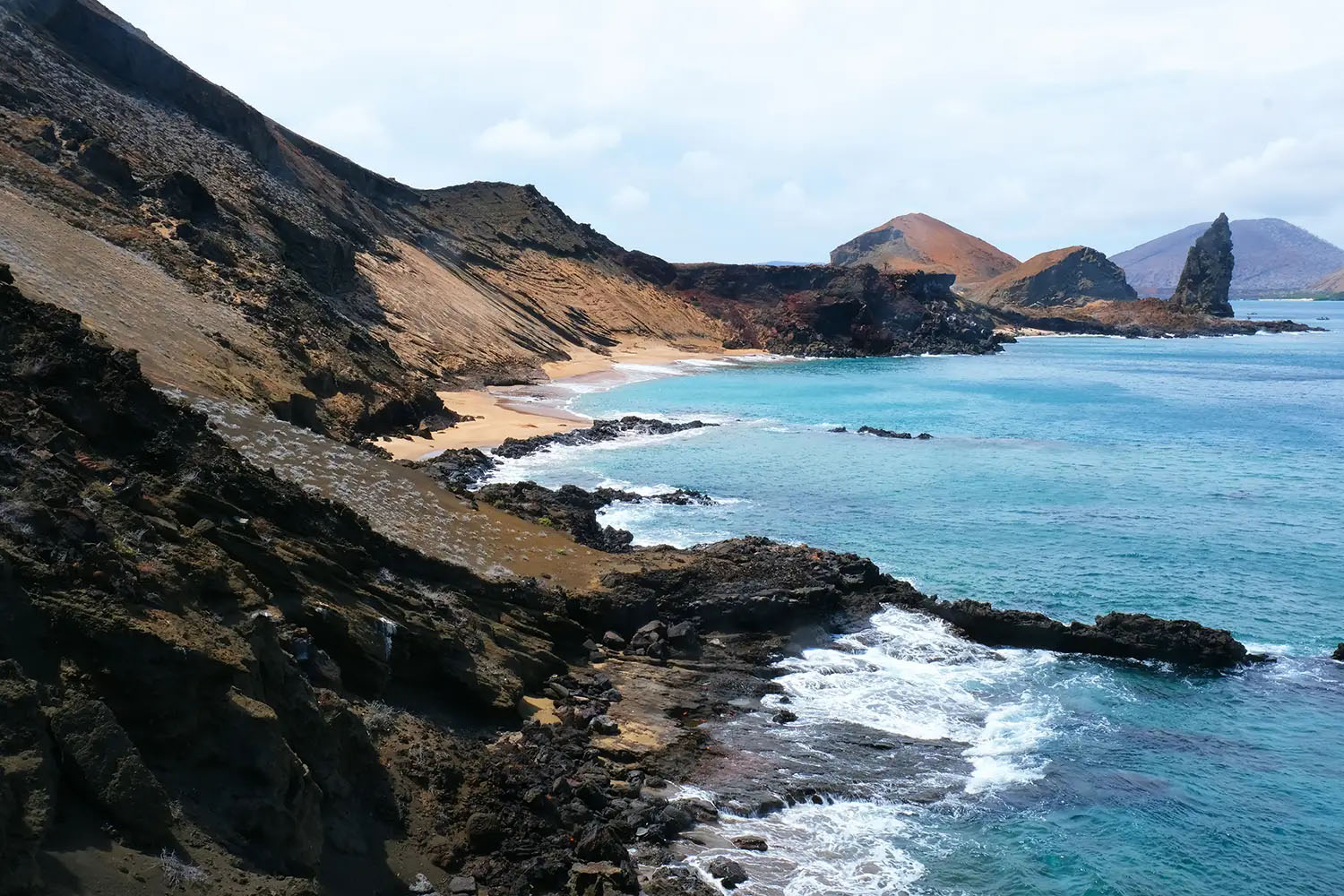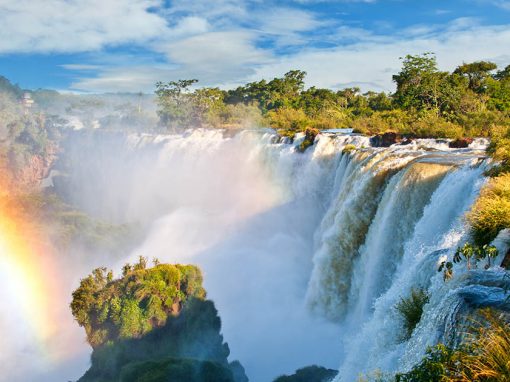The Galapagos Islands are unquestionably one of the best places to visit in South America, and in this comprehensive guide, we’ll uncover 30 of the best things to do in the Galapagos, from encountering unique wildlife to snorkeling in pristine waters and exploring volcanic landscapes.
1. Take a Galapagos Cruise
Without a doubt, the best way to experience the Galapagos Islands is by exploring them on a cruise. The top Galapagos cruise itineraries offer numerous excursions and animal sightings, all with a touch of luxury.
A Galapagos cruise allows you to visit remote islands that are not accessible by island-hopping. Each island hosts a unique array of species, providing diverse wildlife sightings. Due to their unparalleled biodiversity, the Galapagos Islands are part of the protected Galapagos National Park (GNP) and a UNESCO World Heritage Site, which is strictly regulated. Only a maximum of 1,660 people on boats and 180 on day cruises are allowed per day, ensuring you’ll have an intimate and exclusive experience at this extraordinary destination.
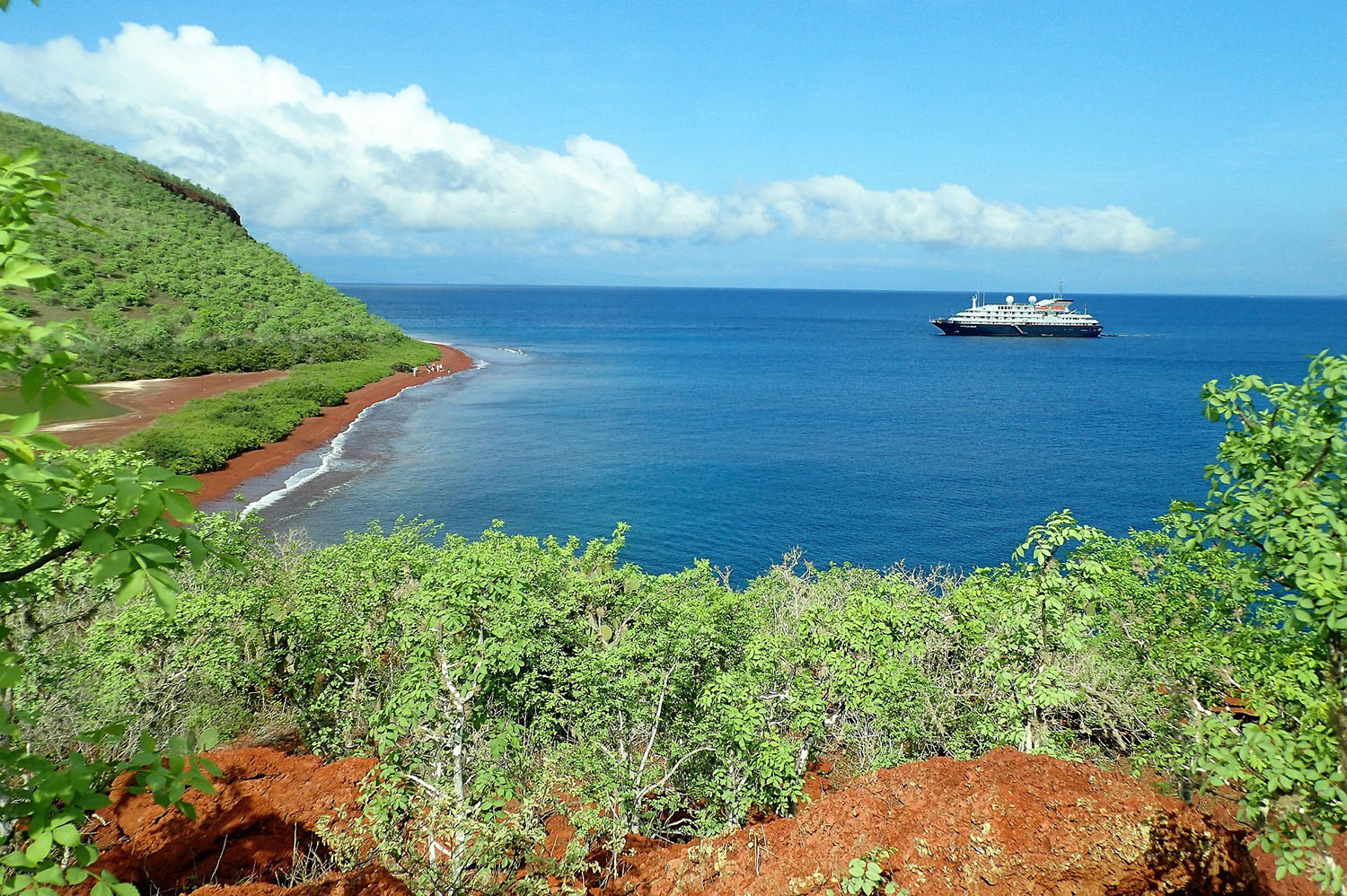
Embark on a spectacular Galapagos cruise. Photo by Gonzo1887 on Pixabay.
Learn more about the best Galapagos cruise tours.
2. Stay at a Hotel and Island-hop
Not sure if a cruise is the right fit for you? Galapagos island-hopping excursions are a beach lover’s dream. Get the best of both worlds in the Galapagos by spending your days taking boat tours from your land-based hotel to nearby islands, exploring the biodiverse wonders of the archipelago. Then, spend your afternoons exploring your home island or relaxing on the gorgeous Galapagos beaches.
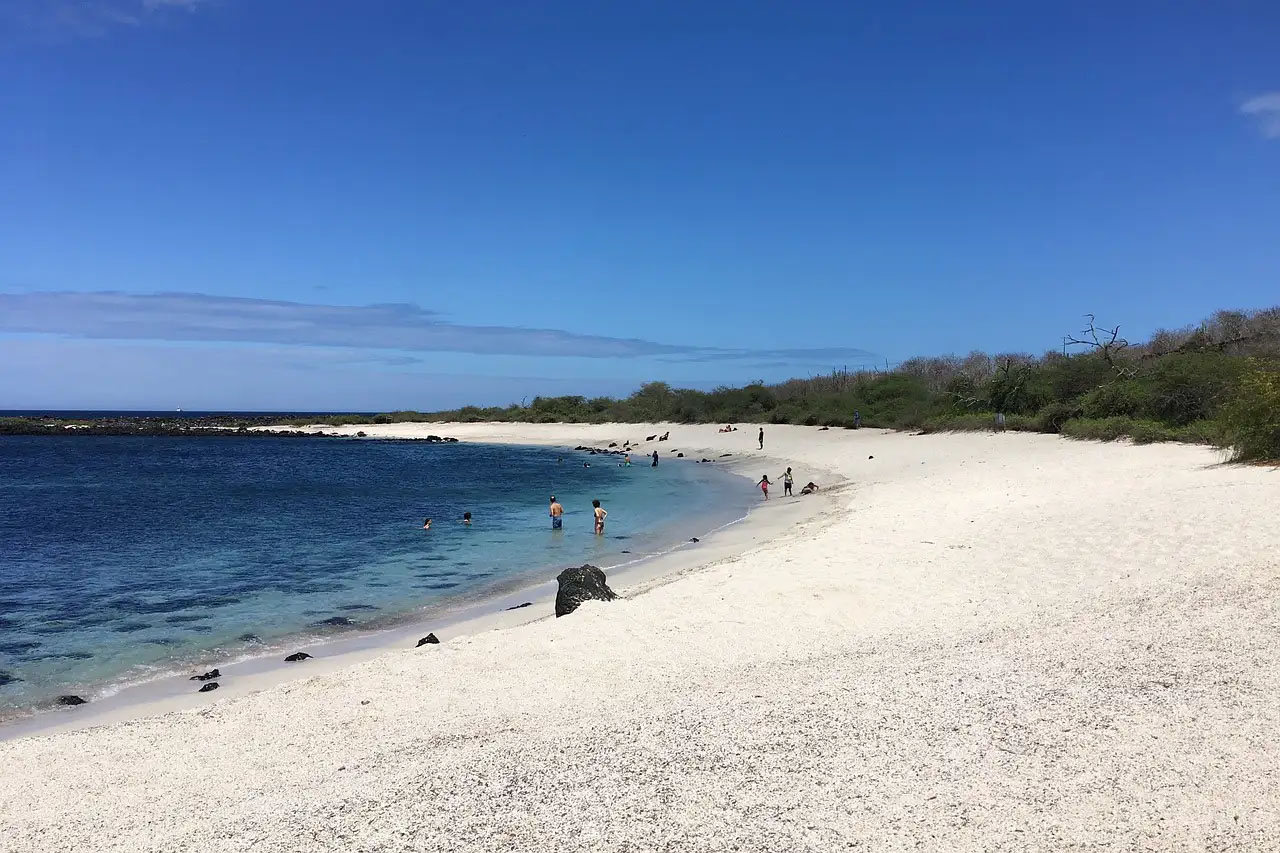
One of the gorgeous beaches of the Galapagos Islands. Photo by holgereberle on Pixabay.
Check out our recommended Galapagos Islands hotels or talk with one of our travel advisors to help plan your Galapagos vacation.
3. Visit Charles Darwin Research Station
A visit to the renowned Charles Darwin Research Station on your journey through the Galapagos Islands is simply a must.
The facility on Santa Cruz Island is dedicated to the conservation and study of the Galapagos Islands’ unique wildlife. Learn about ongoing conservation efforts, see giant tortoises up close, and gain insights into the groundbreaking research that continues to protect and preserve this extraordinary ecosystem.
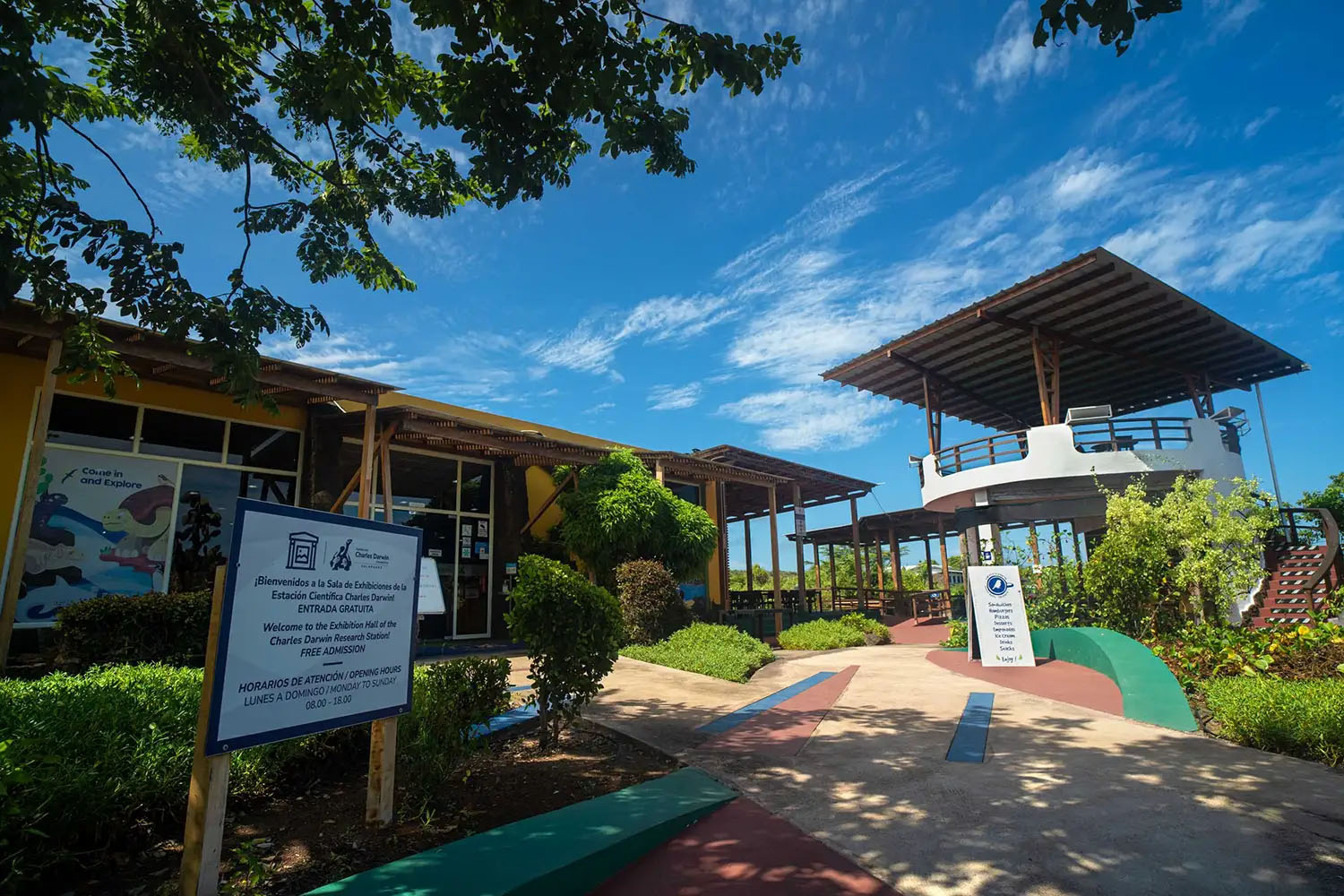
The Charles Darwin Exhibition Hall. Photo by Juan Manuel Garcia-CDF.
4. Snorkel at Devil’s Crown
Devil’s Crown is an islet with an eroded volcanic cone situated close to Punta Cormorant on Floreana Island and is considered to be one of the best snorkeling spots in the Galapagos Islands.
Dive into the vibrant underwater world of this submerged volcanic crater and discover an array of marine life, including colorful fish, sea turtles, rays, and even sharks, as you navigate through the crystal-clear waters and intricate lava formations.
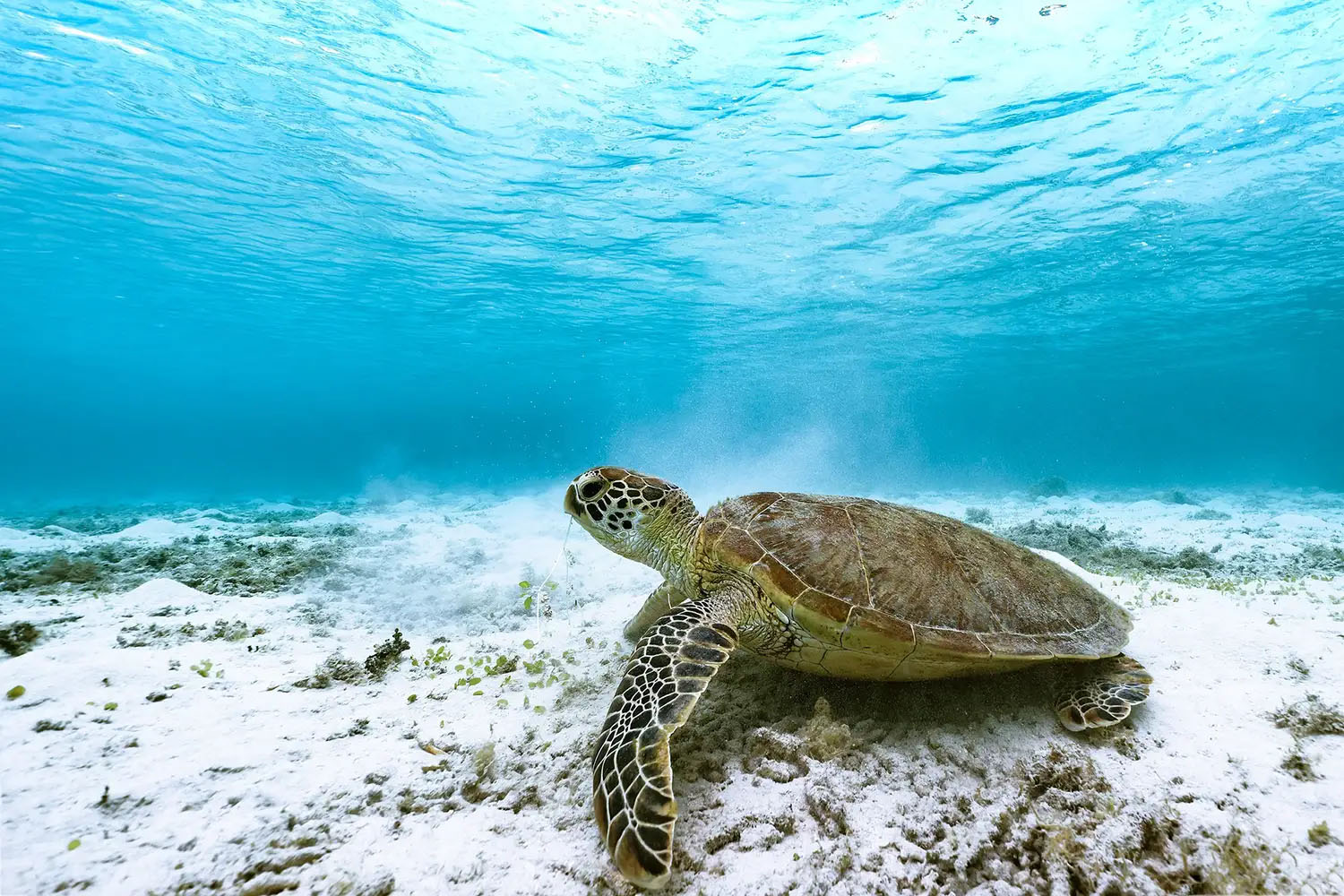
You can expect to see an array of marine life snorkeling at Devil’s Crown. Photo by Kanenori on Pixabay.
5. Visit Puerto Ayora
Explore the bustling heart of Santa Cruz Island, the centrally located and second-largest island in the Galapagos archipelago, where you can enjoy local shops, restaurants, and vibrant markets.
Stroll along the waterfront, visit the Charles Darwin Research Station, and immerse yourself in the lively culture and community of the largest town in the Galapagos Islands.
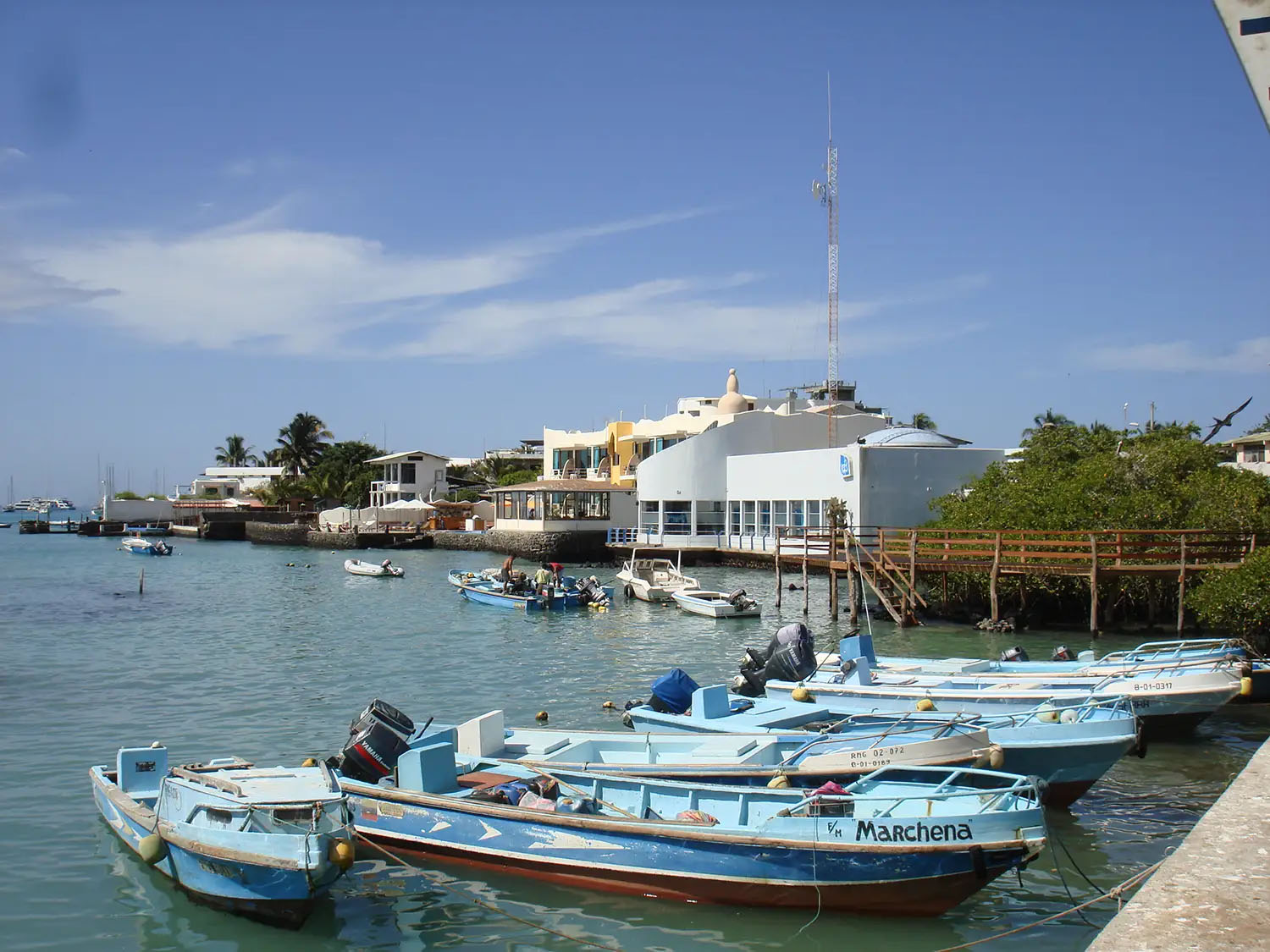
Puerto Ayora. Photo by Pete from USA, CC BY-SA 2.0 <https://creativecommons.org/licenses/by-sa/2.0/deed.en>, via Wikimedia Commons.
Take a look at our recommended Galapagos Islands hotels or talk with one of our travel advisors to help plan your Galapagos vacation.
6. See the marine iguanas on Española Island
Visit Española Island, one of the oldest and most remote islands in the Galapagos archipelago, to observe the unique marine iguanas, which are the only lizards in the world that have adapted to life in the ocean.
Watch these fascinating creatures sunbathe on the rocky shores, swim gracefully in the sea, and feed on algae, showcasing their remarkable adaptation to the Galapagos environment.
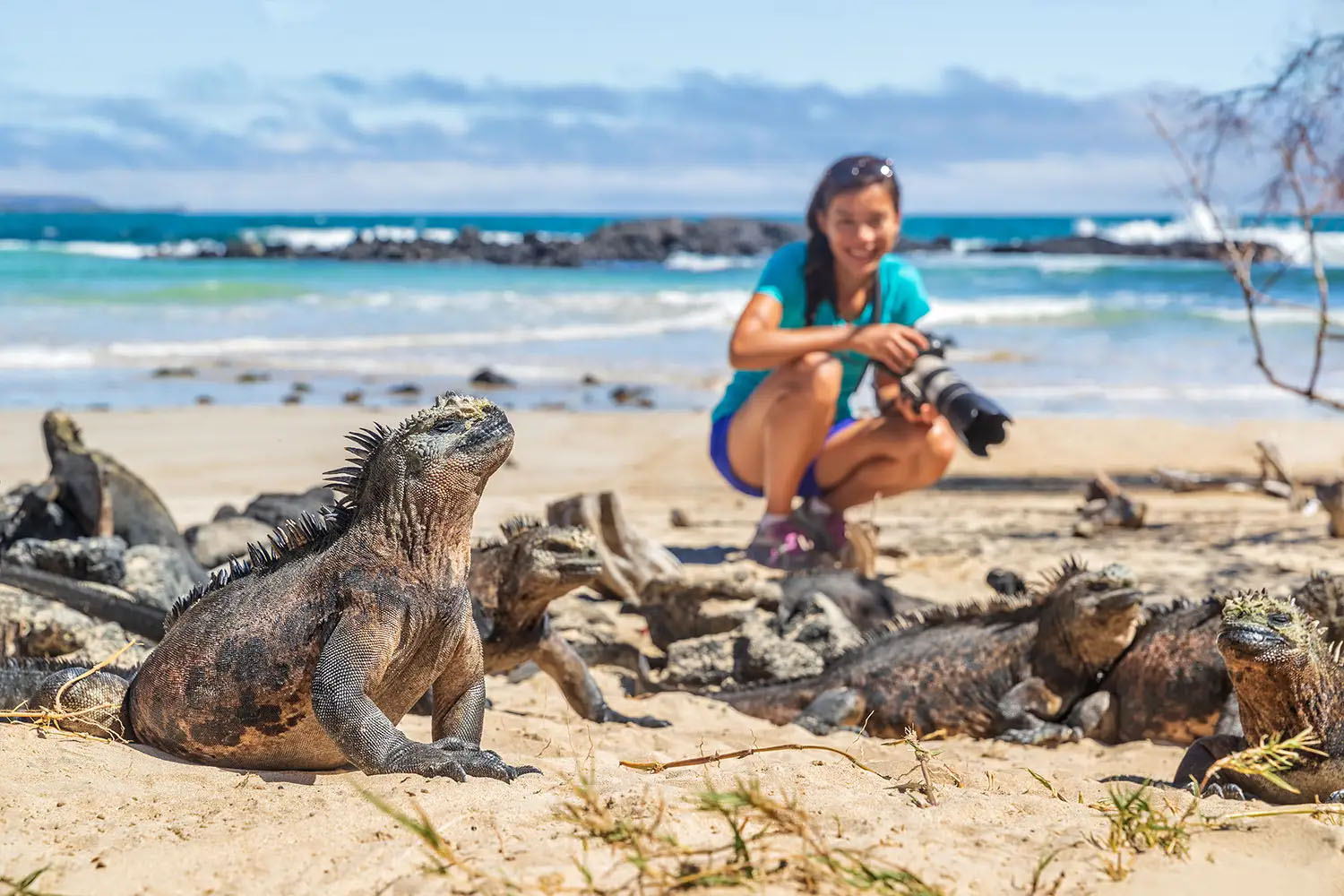
Marine iguanas sunning themselves on the beach. Photo by Maridav on Adobe Stock.
7. Dive at Gordon Rocks
Experience one of the premier diving sites in the Galapagos Islands. Located off the coast of Santa Cruz Island, Gordon Rocks is famous for its thrilling dive experiences featuring strong currents and an abundance of marine life.
Encounter schools of hammerhead sharks, Galapagos sharks, manta rays, sea turtles, and a variety of fish in this underwater paradise. Suitable for advanced divers, Gordon Rocks offers an unforgettable adventure beneath the waves.
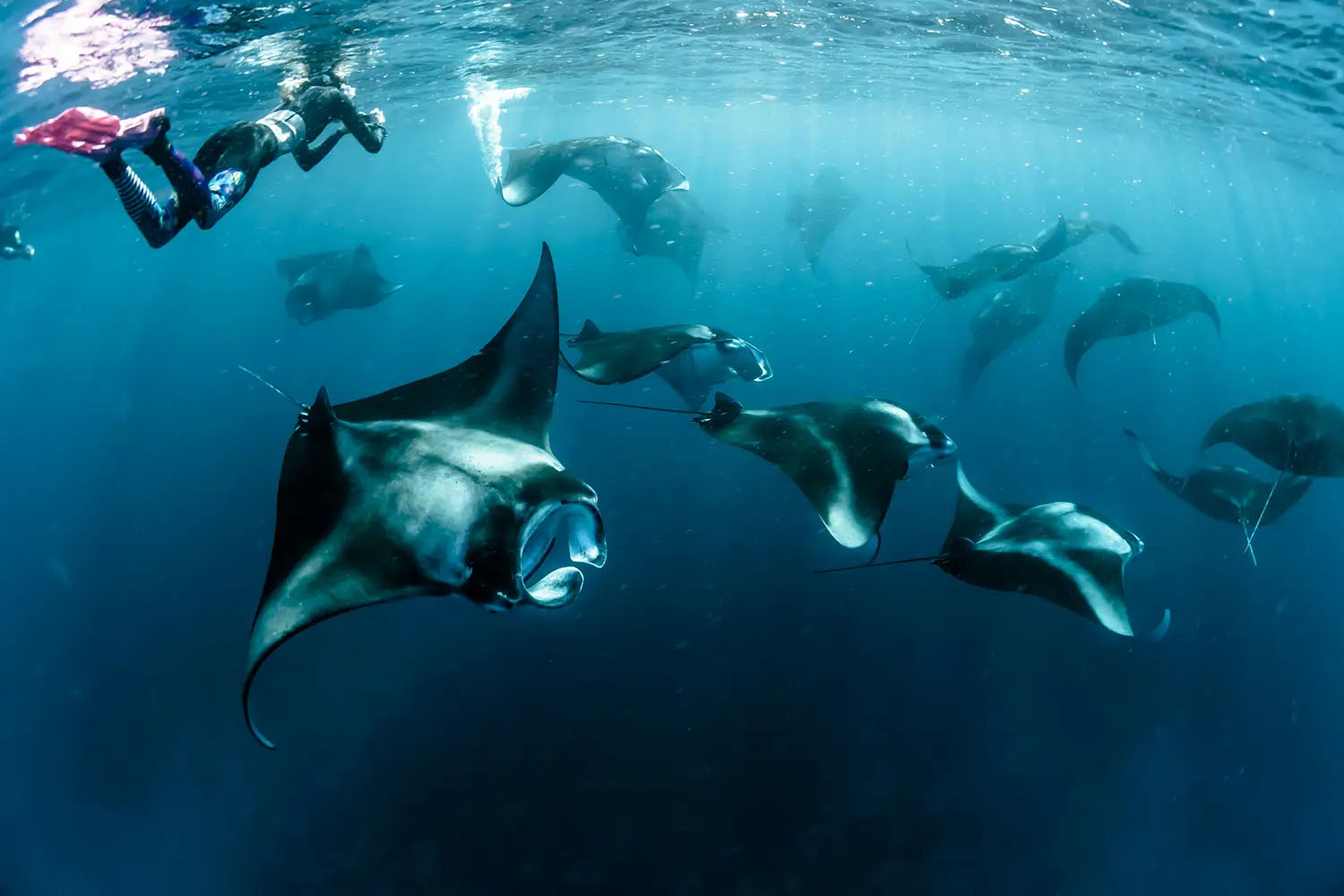
Manta Rays. Photo by Sebastian Pena Lambarri on Unsplash.
8. Explore Lava Tunnels on Santa Cruz
While the incredible diversity of wildlife and stunning landscapes often take center stage, exploring the underground world of lava tunnels, formed by ancient volcanic activity, is an unmissable experience.
Santa Cruz is home to lava tunnels so big that humans can walk through them! These tunnels, also known as lava tubes, provide a unique glimpse into the geological history of the Galapagos Islands. Explore how volcanic activity created these magnificent islands, pretend to be a pirate, or photograph these impressive formations on your Galapagos adventure.
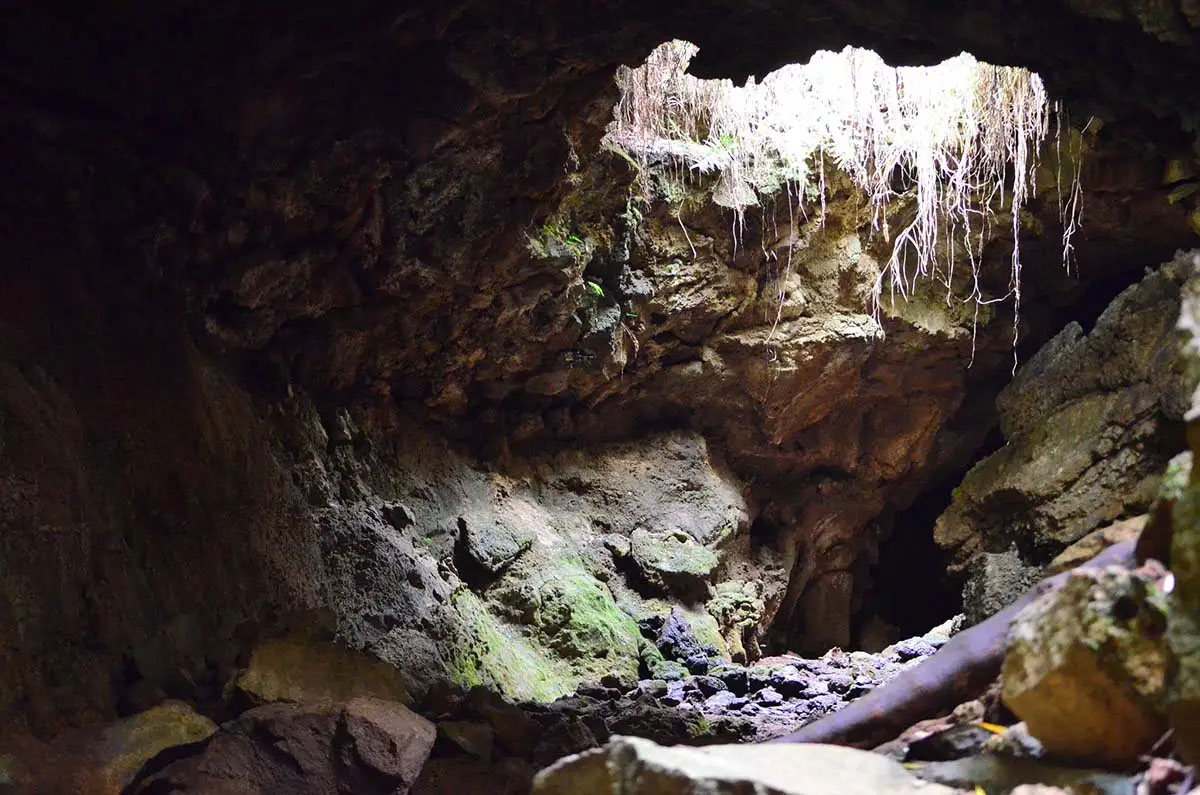
As lava dries, huge air bubbles form into tunnels big enough for humans to explore on their Galapagos adventure. Inside a lava tube, Galápagos by Paul Krawczuk, used under CC BY 2.0 / Compressed from original
9. Climb an Active Volcano: Sierra Negra
A basaltic caldera forms when the summit of a shield volcano, such as those found in the Galapagos Islands, collapses, creating a bowl-shaped crater. The Sierra Negra volcano on Isabela Island has the largest basaltic caldera in the Galapagos.
Embark on an exhilarating hike up the Sierra Negra, one of the most active volcanoes in the Galapagos Islands. This trek offers breathtaking views of the world’s second-largest volcanic crater. Traverse diverse landscapes, from lush highlands to barren lava fields, and witness the raw power of nature. The panoramic vistas from the summit are truly unforgettable, making this a must-do adventure for nature enthusiasts and thrill-seekers alike.
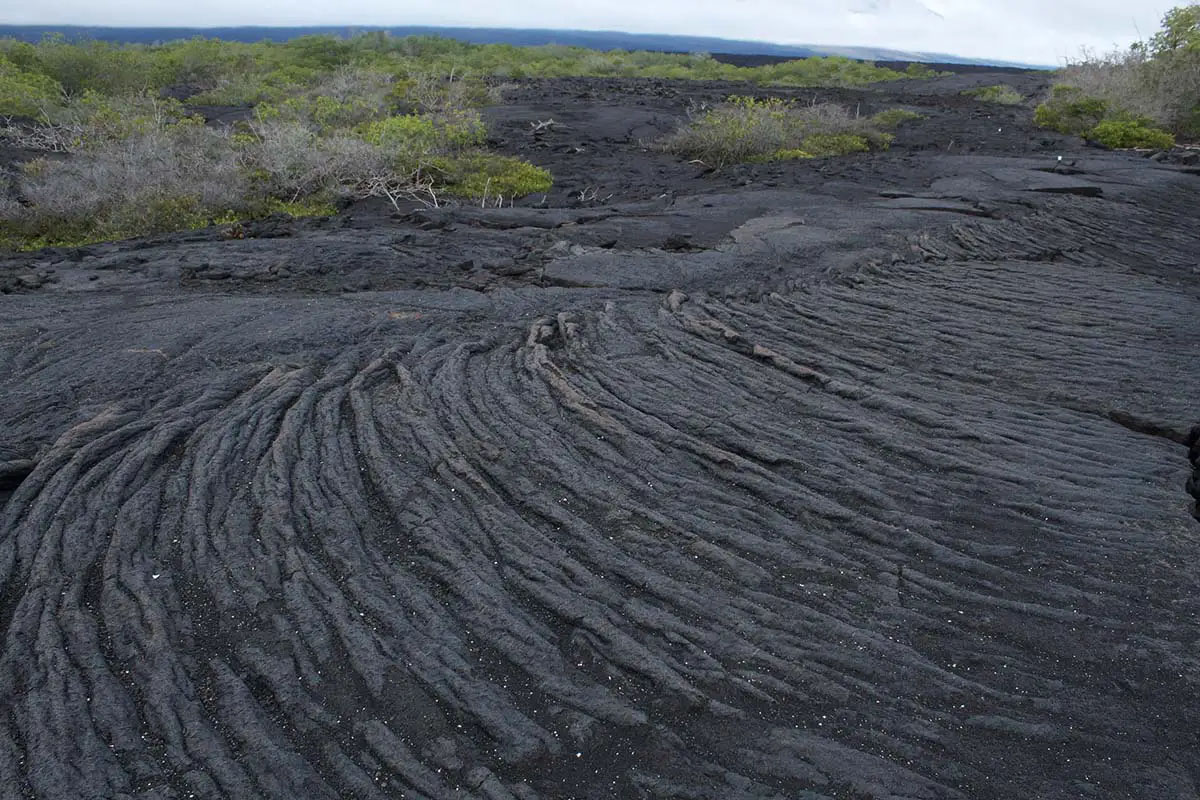
Galapagos island day tours include visits to see lava formations, some of which are very recent. Image: Ropey lava” by Brian Gratwicke, used under CC BY 2.0 / Compressed from original
If you are ready for the adventure of a lifetime, simply get in touch with one of our travel advisors to help plan your Galapagos vacation.
10. Snorkel with sea lions at La Lobería
The Galapagos archipelago boasts an abundance of breathtaking snorkeling spots, and La Lobería on San Cristóbal Island is no exception. Immerse yourself in its crystal-clear waters for an unforgettable snorkeling adventure.
Enjoy playful interactions with friendly sea lions as they swim gracefully around you. In addition to sea lions, you may also encounter colorful fish, sea turtles, and rays in this vibrant underwater ecosystem. La Lobería offers a unique opportunity to get up close with some of the Galapagos Islands’ most charismatic marine life.
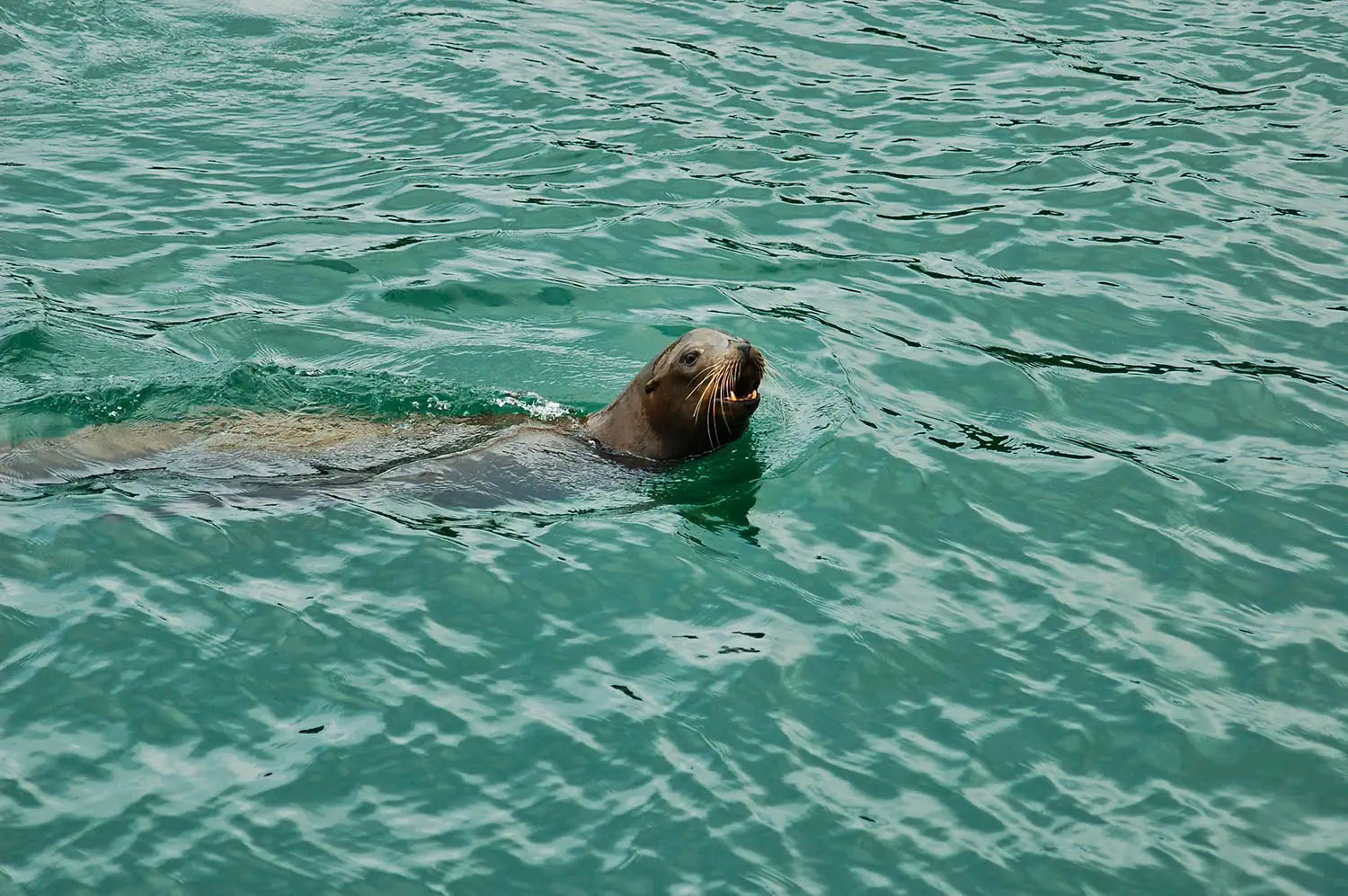
Can you imagine yourself snorkeling with sea lions? Photo by Kosta Smith on Pexels.
11. Admire the Galapagos Islands Volcanoes
The Galapagos archipelago is a series of volcanic islands located 620 miles (1000 km) from mainland Ecuador. This unique location is where three ocean currents converge and tectonic plates meet, and over time, the shifting of tectonic plates and volcanic eruptions elevated the earth’s surface above sea level, creating the islands. Ongoing volcanic activity that is constantly altering the landscape of these islands ensures that no two visits are alike.
You can clearly feel the contrast between the textured ground of Isla Fernandina (the youngest island) and the more eroded Isla Espanola (the oldest island). Amazingly, there’s also a chance that you may witness an active eruption on your Galapagos trip, as 13 of the 21 volcanoes in the Galapagos archipelago are still active, and since Charles Darwin’s visit, there have been more than 60 eruptions!
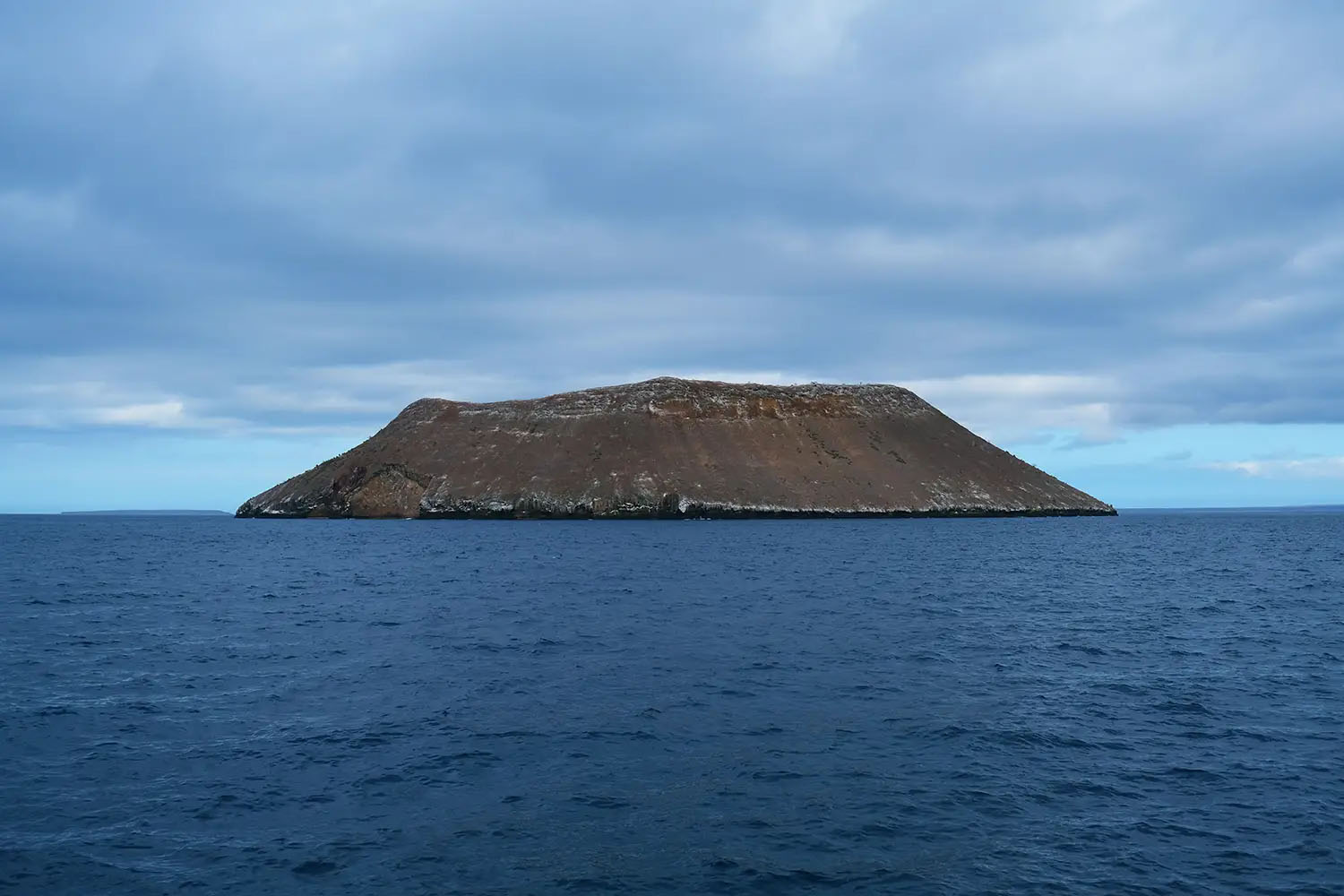
The Galapagos archipelago is a series of volcanic islands. Photo by Nathalie Marquis on Unsplash.
12. See Giant Tortoises
Seeing giant tortoises in the Galápagos Islands is a remarkable experience that provides a glimpse into one of nature’s most fascinating species. The Galapagos tortoises are the largest living species of tortoise, weighing up to 920 lbs (417 kg)!
Your island-hopping or cruise itinerary will include a stop at one or more of the many reserves or research centers listed below to see these giants.
- Santa Cruz Island: Charles Darwin Research Center on Santa Cruz Island
- Santa Cruz Island: El Chato Tortoise Reserve Santa Cruz
- San Cristóbal Island: Galapaguera de Cerro Colorado on San Cristóbal Island
- Floreana Island: Asilo de la Paz on Floreana Island
- Isabela Island: Breeding Center “Arnaldo Tupiza” on Isabela Island
Expect some delays, though, as it’s not uncommon for these big creatures to also cause some traffic disruptions as they cross the road!

Galapagos tortoises are the largest living species of tortoise. Photo by fe31lopz on Pixabay.
13. Kayak in Tortuga Bay
Kayaking in Tortuga Bay offers a serene and immersive experience amidst the pristine beauty of the Galapagos Islands. Paddle through crystal-clear waters teeming with marine life, surrounded by mangroves and stunning volcanic landscapes. Encounter playful sea lions, graceful sea turtles, and diverse bird species as you explore this captivating natural sanctuary.
The Galapagos Islands are truly a paradise. If you are ready for the adventure of a lifetime, simply get in touch with one of our travel advisors to help plan your Galapagos adventure.
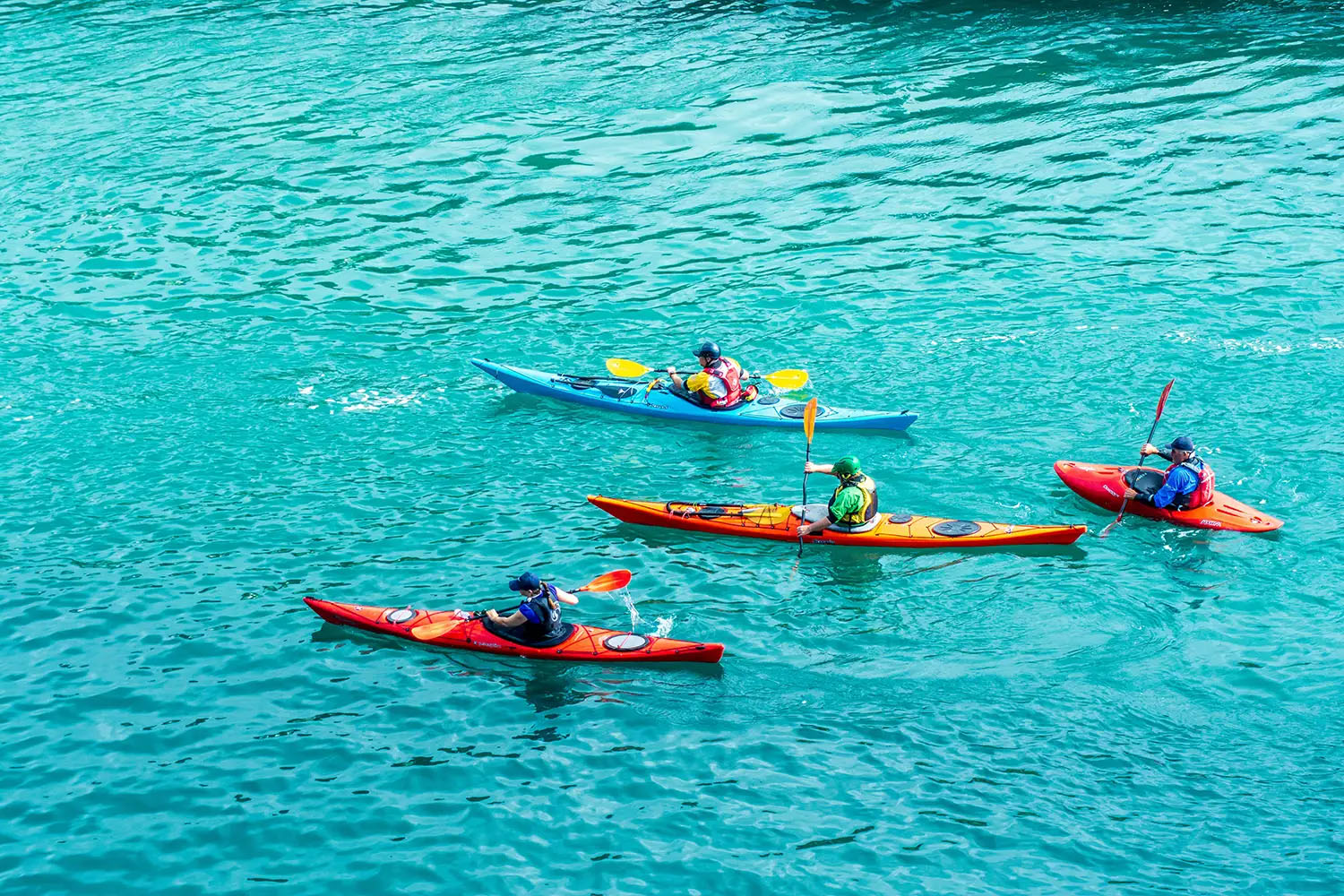
A tranquil and engaging experience in the unspoiled splendor of the Galapagos Islands. Photo by Brandon McDonald on Unsplash.
14. Go Bird Watching
Bird watching in the Galapagos Islands promises an unforgettable adventure for enthusiasts and nature lovers alike. With expert guides to enhance your experience, discover the unique charm of Galapagos avifauna amid stunning landscapes.
Immerse yourself in diverse habitats ranging from lush highlands to volcanic shores, where you can observe endemic species like the iconic blue-footed boobies, magnificent frigatebirds with their impressive displays, Galapagos penguins, and Darwin’s finches showcasing their remarkable adaptations.
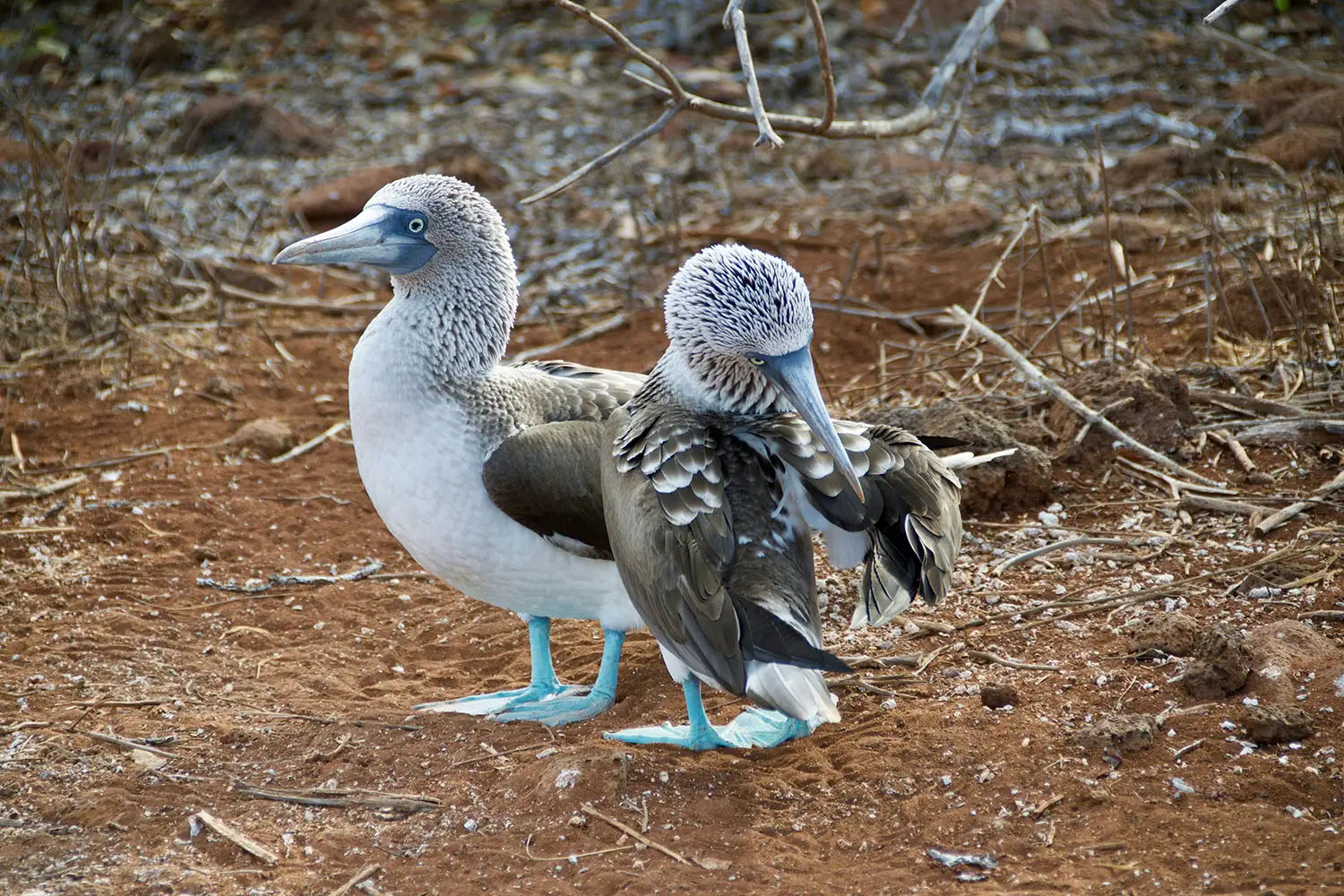
Iconic blue-footed boobies. Photo by Andy Brunner on Unsplash.
15. Visit the Wall of Tears on Isabela Island
Visit the Wall of Tears in the Galapagos to explore a site rich with history and poignant significance. Once admired by pirates and located on Isabela Island, this massive stone wall was constructed by prisoners in a penal colony between 1945 and 1959. The arduous labor and harsh conditions endured by the inmates give the Wall of Tears its haunting name and profound historical weight. Many lives were lost due to harsh conditions, mistreatment, and accidents, and it is believed by some that if you go near the wall, you can hear the cries of the men who worked to build it.
As you walk the trail leading to the wall, you’ll also enjoy stunning views of the island’s natural beauty, including diverse wildlife and lush landscapes, making this visit both an educational and reflective experience.
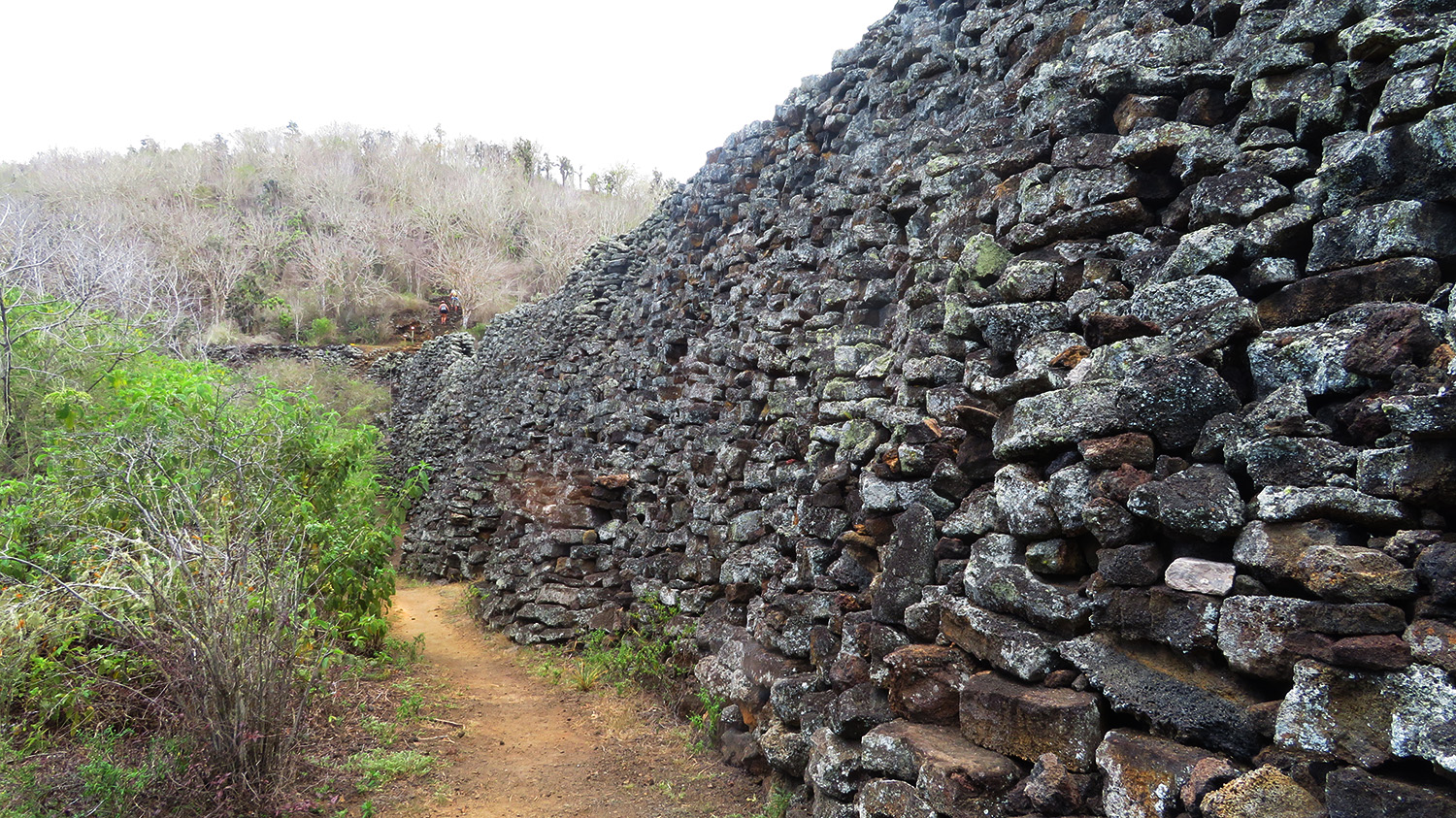
The Wall of Tears. Source: Torbenbrinker, CC BY-SA 4.0 <https://creativecommons.org/licenses/by-sa/4.0>, via Wikimedia Commons.
16. Swim with sharks at Kicker Rock
Explore the thrilling underwater world by swimming with sharks at Kicker Rock, one of the Galapagos Islands’ premier diving and snorkeling sites.
This striking rock formation, also known as León Dormido, rises dramatically from the ocean and is renowned for its abundant marine life. As you swim through the clear waters around Kicker Rock, you can encounter various shark species, including hammerheads, Galapagos sharks, and white-tip reef sharks. The experience also offers opportunities to see sea turtles, rays, and a myriad of colorful fish, making it a must-visit destination for adventure seekers and marine enthusiasts.
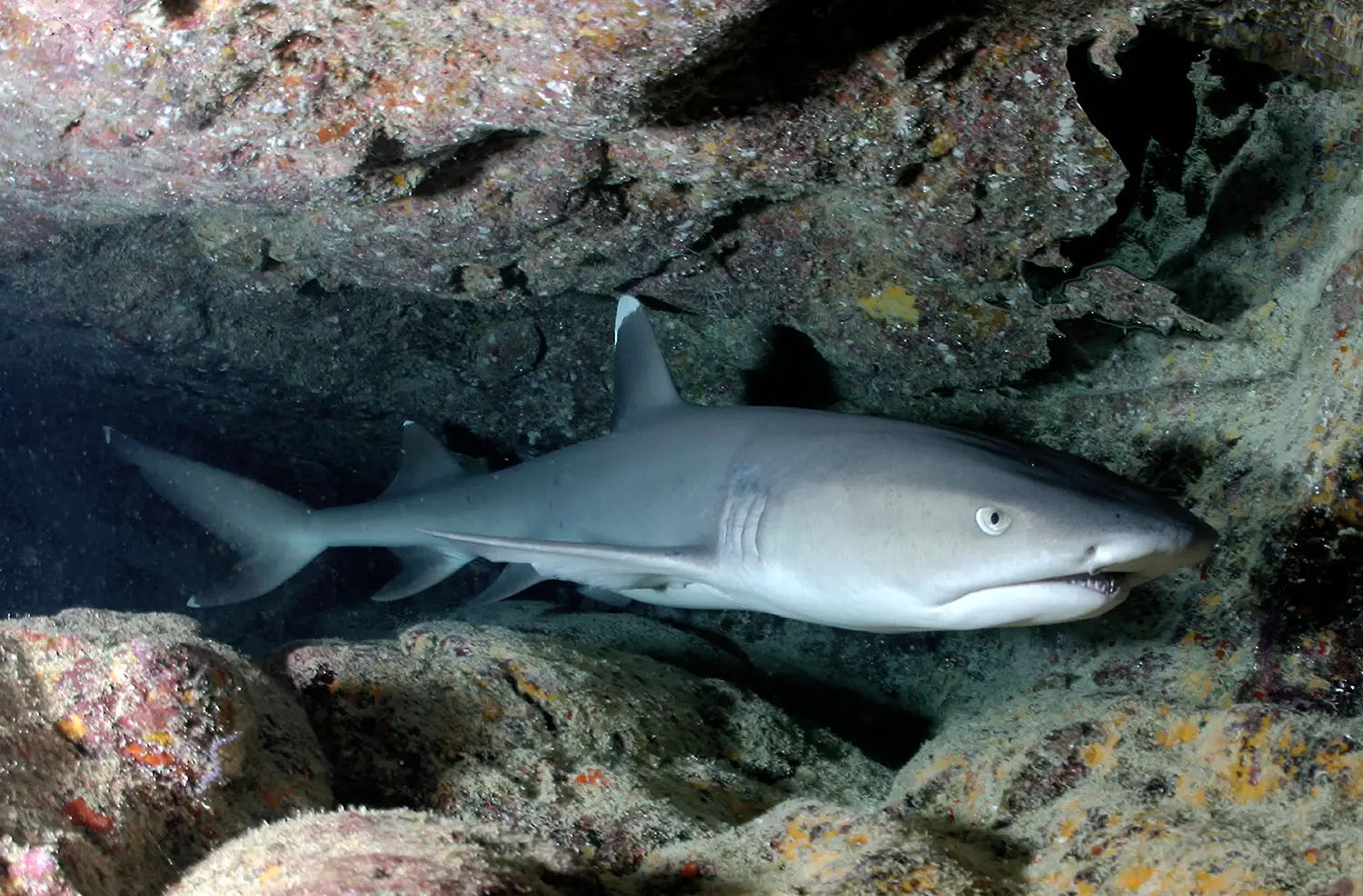
White-tip reef shark. Source: http://www.magazine.noaa.gov/stories/mag203.htm, Public domain, via Wikimedia Commons
17. Visit the Interpretation Center on San Cristobal Island
Visit the Gianni Arismendy Interpretation Center to get an overview of everything you’ll need to know for your Galapagos vacation and gain a deeper understanding of the archipelago’s unique natural and human history. The Center serves as both an educational resource and a gateway to further exploration of the incredible Galapagos Islands.
This center houses four laboratories dedicated to studying all forms of life on the Galapagos Islands and offers engaging exhibits on the islands’ history, biology, geology, ecology, and conservation efforts, as well as insights into the impact of human settlement. Interactive displays and informative panels make it an educational experience for visitors of all ages. The center is surrounded by scenic walking trails, providing an opportunity to enjoy the island’s natural beauty while learning about the vital importance of preserving this extraordinary environment.
We highly recommend this as one of the things to do in the Galapagos Islands to give context to your time in Ecuador, even if you’ve already learned a lot on your trip.
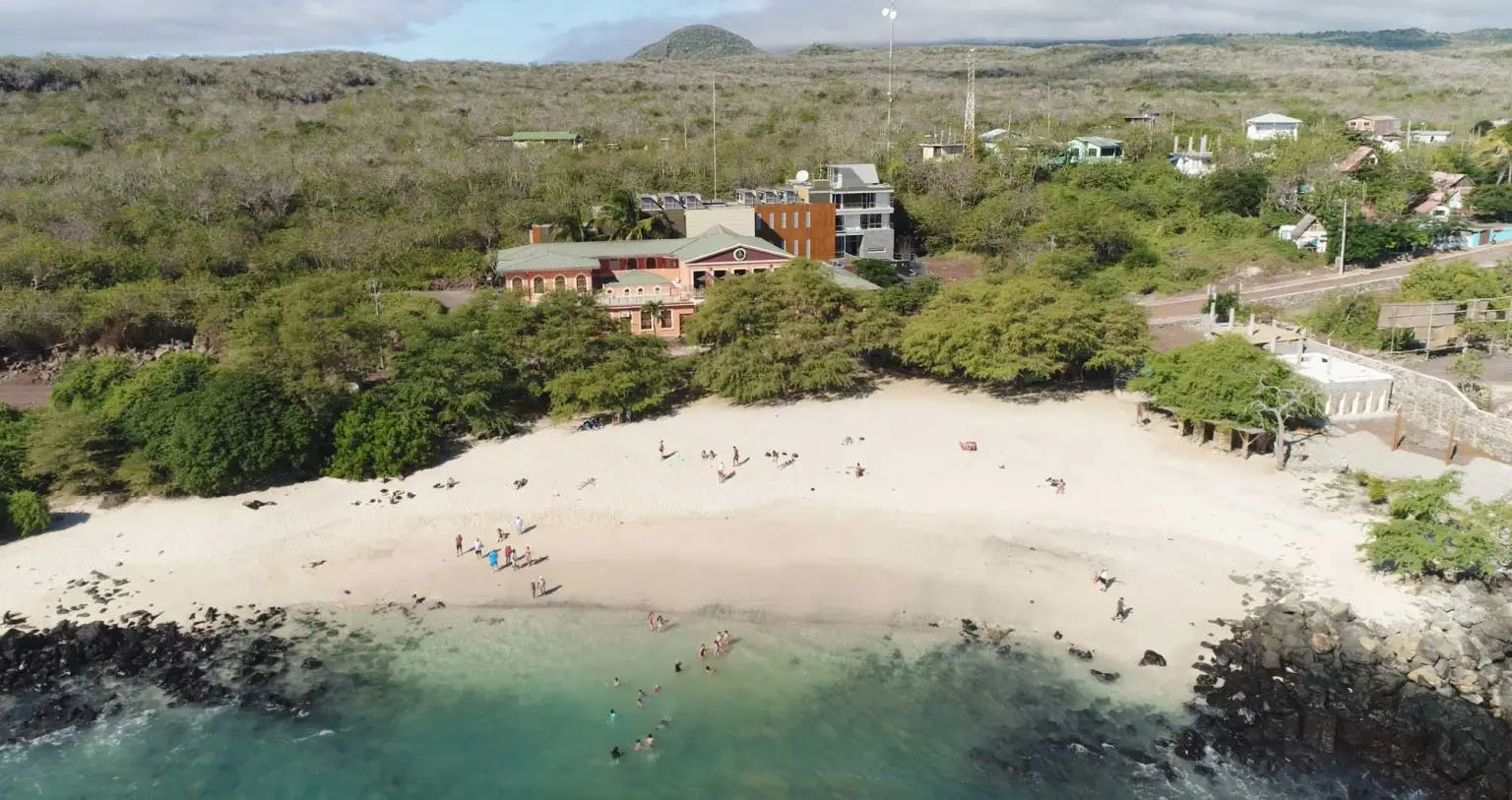
The Galapagos Science Center (GSC) with its four laboratories. Source: https://galapagos.unc.edu/gsc-overview/, UNC, Center for Galapagos Studies
18. Spot flamingos at Las Tintoreras
Venture to Las Tintoreras, a captivating destination renowned for its unique volcanic landscapes and tranquil lagoons, where you can observe flamingos in their natural habitat.
This serene and picturesque location provides an ideal setting for encountering these graceful birds. As you explore the area’s diverse ecosystem, keep an eye out for the distinctive pink plumage of the flamingos wading through the shallow waters. The experience offers not only a unique wildlife sighting but also an opportunity to appreciate the beauty and biodiversity of the Galapagos Islands.
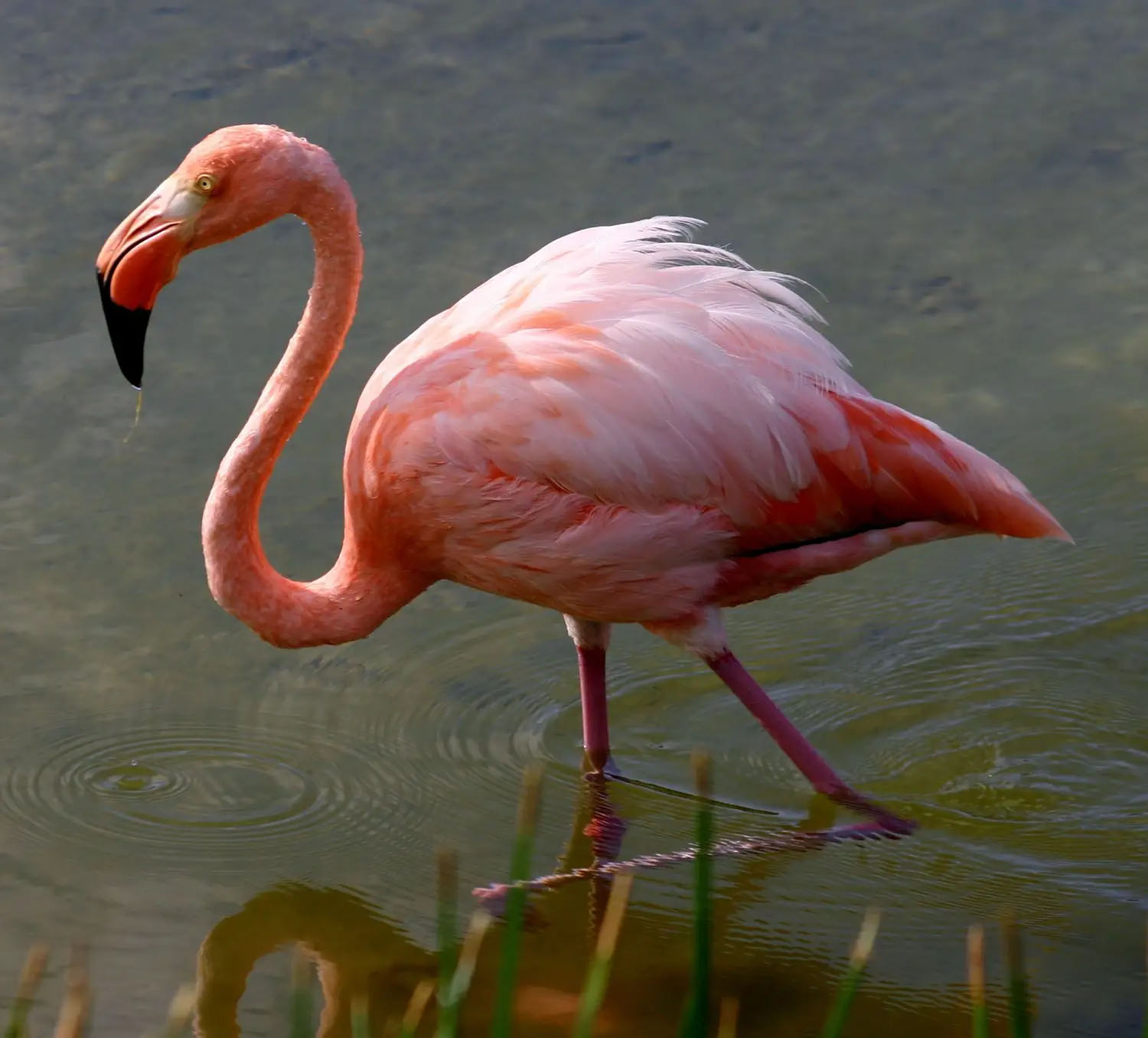
A flamingo on Isabela Island. Source: Charles J. Sharp, CC BY-SA 3.0 <https://creativecommons.org/licenses/by-sa/3.0>, via Wikimedia Commons
If you are ready to start planning your Galapagos adventure, simply get in touch with one of our travel advisors, who will craft the perfect itinerary for you!
19. Hike to Darwin Lake
Embark on a hike to Darwin Lake, a strikingly beautiful saltwater crater lake on Isabela Island that is nestled within a tuff cone, formed by volcanic activity, and separated from the ocean by a narrow strip of land.
This scenic trek offers breathtaking views of the surrounding volcanic landscapes and lush vegetation. As you make your way to the lake, you’ll have the opportunity to encounter a variety of native wildlife, including finches, lava lizards, and other unique species. The trail culminates at the edge of the tranquil lake, where you can marvel at its serene beauty and reflect on the natural wonders of the Galapagos Islands.
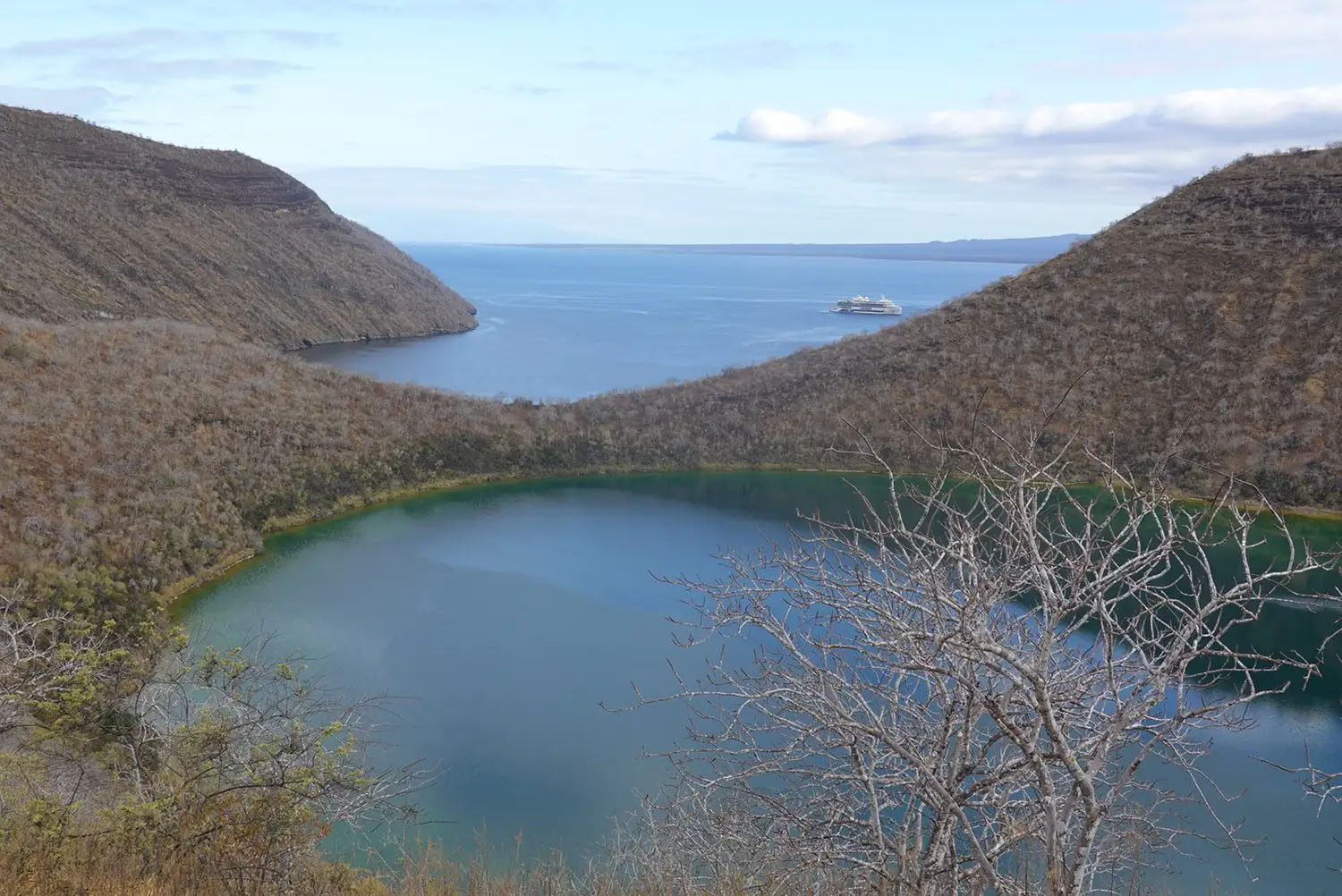
Darwin Lake on Isabela Island. Source: MasterfulNerd, CC BY-SA 4.0 <https://creativecommons.org/licenses/by-sa/4.0/deed.en>, via Wikimedia Commons
20. Hand Deliver a Letter from Post Office Bay
Post Office Bay on Floreana Island is only one example of how humans adapted to the Galapagos’ ecology. This isolated cluster of islands offered sailors of the 1800’s a place and opportunity to leave letters so that other sailors could deliver them on their return journeys to the mainland.
Today, the tradition is still carried on, and tourists traveling from island to island can also take a letter from Post Office Bay and deliver it, or leave postcards and letters in the barrel. This engaging activity connects travelers through a shared sense of adventure and history, adding a personal touch to your Galapagos experience.
Have more questions like: when is the best time to go, how do you get to the Galapagos Islands, or what to pack? Check out our Galapagos Travel Tips for everything you need to know while planning.

Post Office Bay on Floreana Island. Source: ProfessorX, CC BY-SA 3.0 <https://creativecommons.org/licenses/by-sa/3.0>, via Wikimedia Commons
21. Photograph Pinnacle Rock on Bartolome Island
This experience is a must for photography enthusiasts and nature lovers alike. Capture the iconic Pinnacle Rock, one of the most photographed landmarks in the Galapagos. This landmark is on Bartolome Island, a tiny island that offers a combination of dramatic scenery, diverse wildlife, and recreational activities.
Pinnacle Rock is a striking volcanic formation that rises dramatically from the turquoise waters, offering a breathtaking backdrop for stunning photographs. As you capture the perfect shot, you can also expect to see penguins, sea lions, starfish, and anemones, so be sure to bring your binoculars and camera!
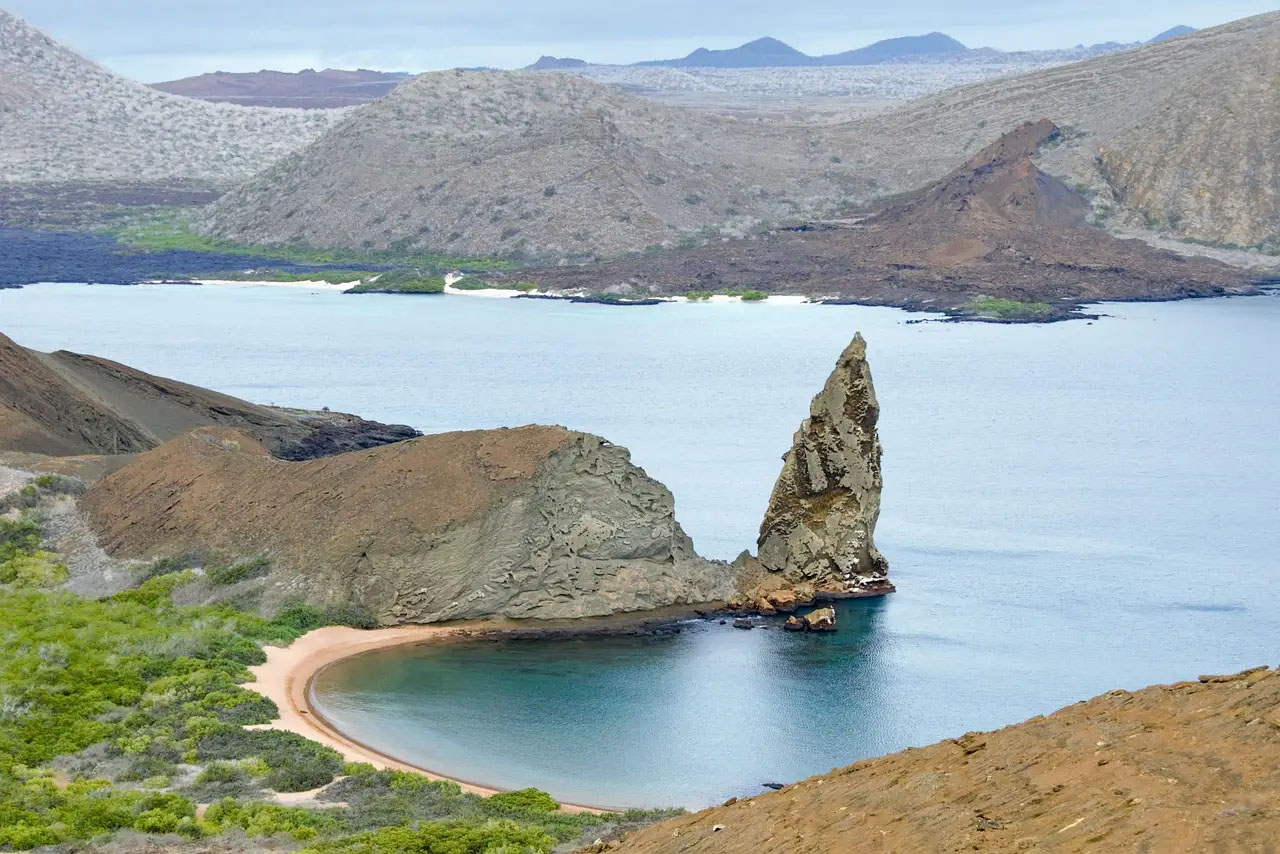
Pinnacle Rock on Bartolome Island. Photo by pen_ash on Pixabay.
22. Enjoy Glass-Bottom Boat Rides
Do you want to experience the vibrant underwater world of the Galapagos without getting wet? This is absolutely possible by taking a glass-bottom boat ride!
This family-friendly activity will allow you to glide over the ocean and observe the rich marine life that inhabits the clear waters surrounding the islands. You’ll have an unobstructed view of colorful fish, sea turtles, rays, and even playful sea lions swimming beneath the boat. Knowledgeable guides on board will explain the marine biology and ecology of the area.
It doesn’t matter whether you’re looking to relax and take in the sights or learn more about the incredible biodiversity of the Galapagos; a glass-bottom boat ride offers a memorable and educational adventure for everyone!
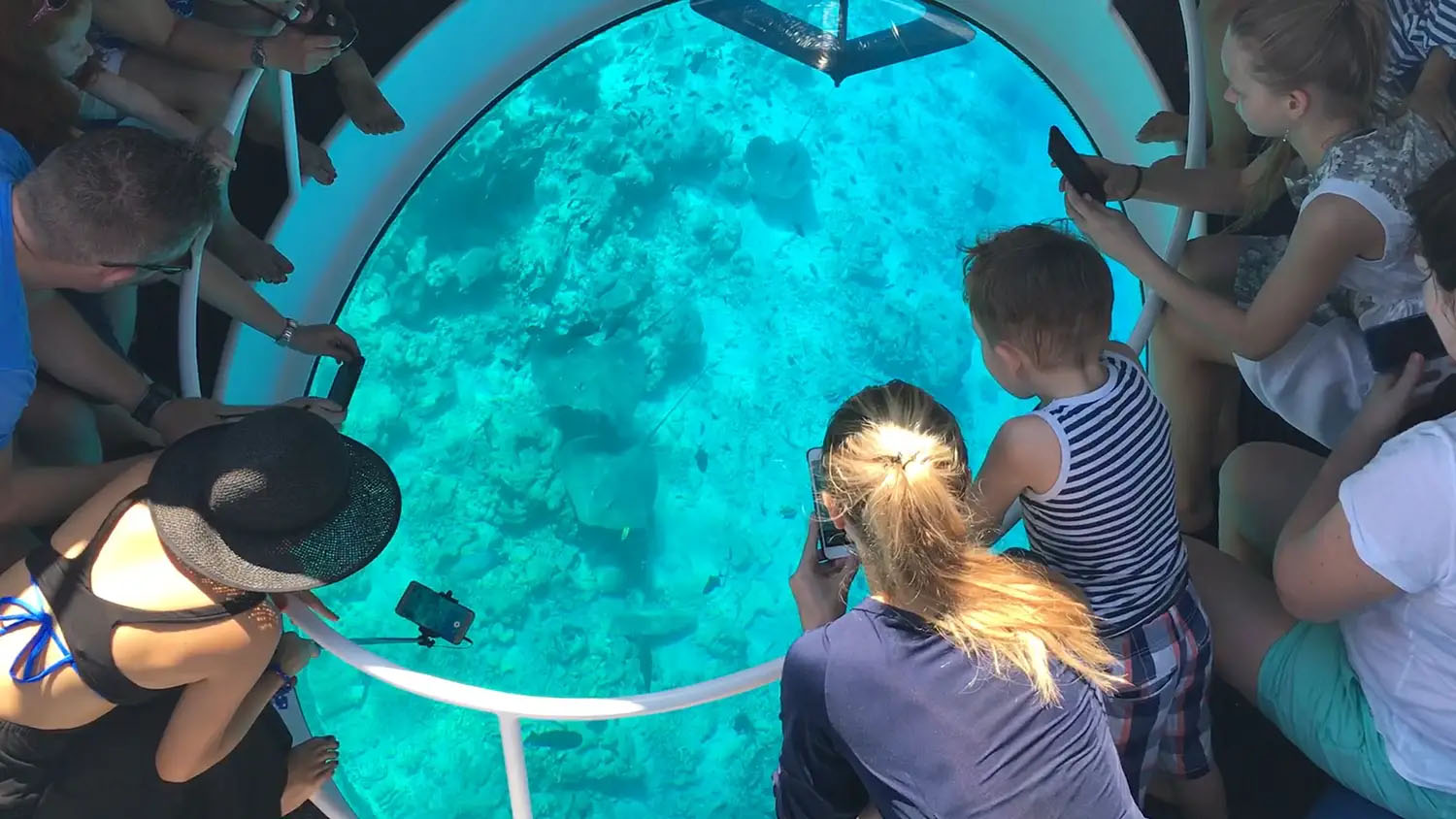
Experience the vibrant underwater world of the Galapagos. This photo is for illustrative purposes only. Source: ElizabethZa, CC BY-SA 4.0 <https://creativecommons.org/licenses/by-sa/4.0>, via Wikimedia Commons
23. Jump off a Cliff at Las Grietas on Santa Cruz
Experience the thrill of jumping off a cliff at Las Grietas on Santa Cruz Island in the Galapagos. Las Grietas is a stunning natural crevice filled with crystal-clear water.
Not only is this where a mixture of saltwater and freshwater meet, creating one of the many unique ecosystems found on the Galapagos Islands, but it also offers adventurous visitors a unique and exhilarating experience. Surrounded by dramatic volcanic rock formations, the plunge into the refreshing water below provides an unforgettable adrenaline rush.
After your jump, take some time to swim and snorkel in this piece of paradise, where you can explore the diverse marine life that inhabits this hidden gem. Las Grietas is a must-visit destination for thrill-seekers and nature lovers alike, offering a perfect blend of excitement and natural beauty.
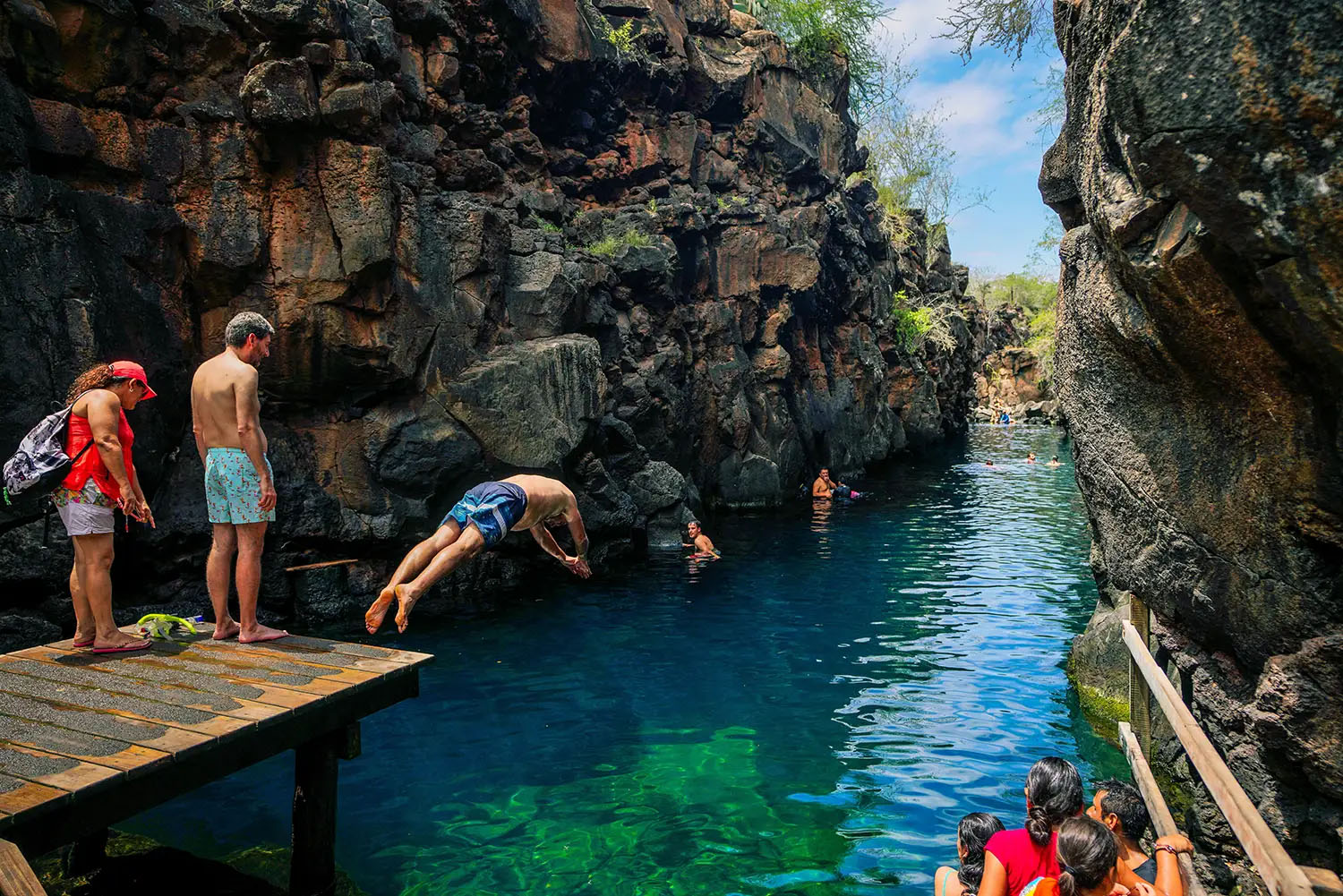
The mystical Las Grietas on Santa Cruz Island. Photo by Kiyoshi on Unsplash.
Are you ready to take the plunge into planning your Galapagos adventure? Simply get in touch with one of our travel advisors, who will craft the perfect itinerary for you!
24. Surf on San Cristobal Island
With most of the Galapagos Islands being protected, many surfing spots are actually illegal for tourists to surf; however, this isn’t the case on San Cristobal Island.
Surfing on San Cristobal Island offers thrilling waves and picturesque beaches, and with its diverse coastline and consistent swells, the island provides ideal conditions for both beginners and experienced surfers alike. Surf season in the Galapagos is year-round but is divided into the north swell (December to April) and the south swell season (April to November).
Whether you’re catching waves at Carola Beach, known for its long rides and sandy bottom, or exploring the breaks near Tongo Reef, San Cristobal promises an exhilarating surfing experience amidst stunning Galapagos scenery.
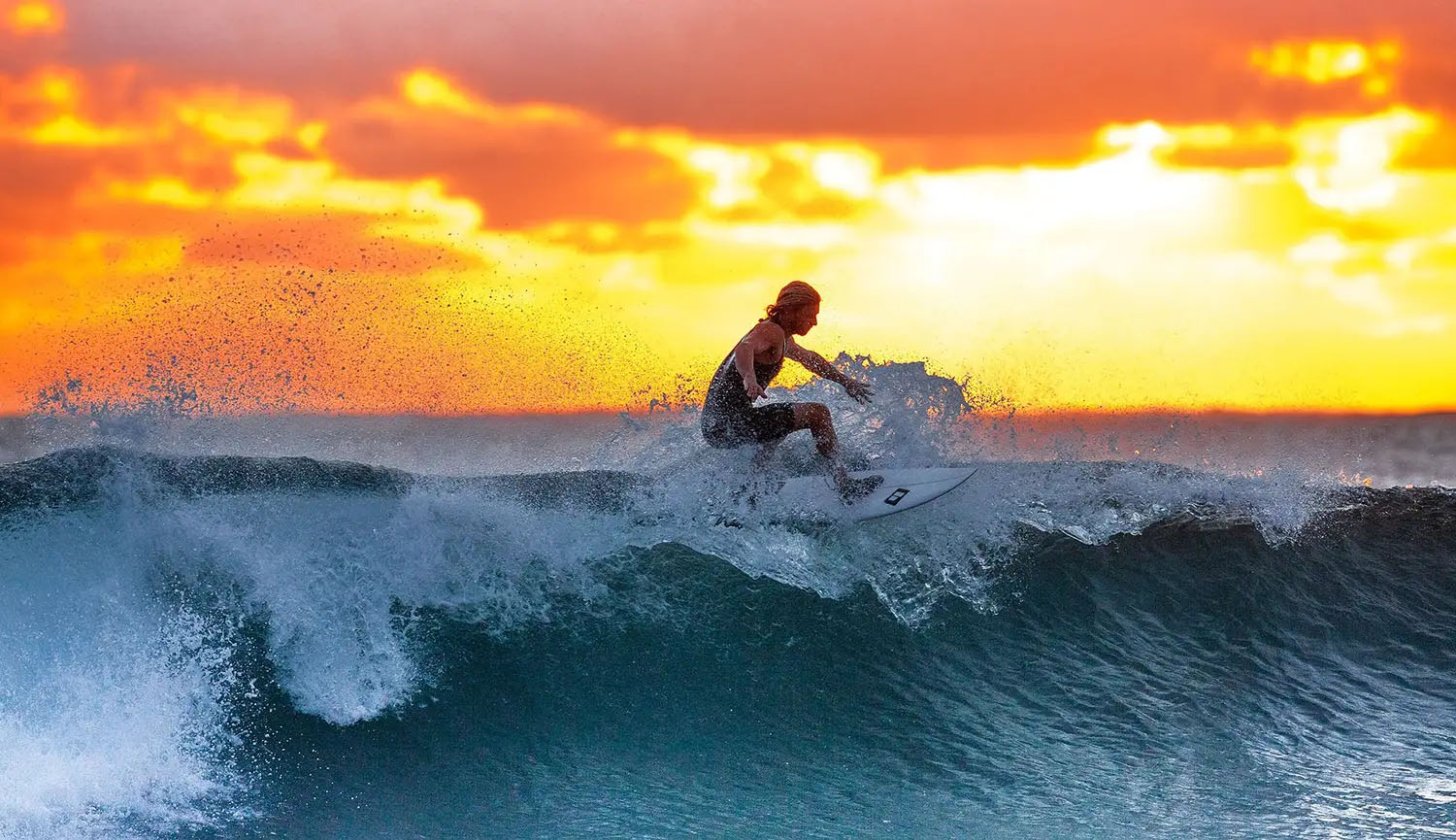
Surfing on San Cristobal Island offers thrilling waves and picturesque beaches. Photo by Kanenori on Pixabay.
25. Dive With Whale Sharks or Manta Rays
If you’re a diver, you haven’t experienced it all until you’ve explored the rich underwater ecosystems of the majestic Galapagos Islands, or more specifically, the exhilaration of diving alongside whale sharks or manta rays!
The Galapagos diving calendar revolves around two primary seasons: whale shark sightings peak from June to November when plankton levels are high, whereas various species of manta rays frequent the waters from December to May. Encountering these majestic creatures in their natural habitat offers a thrilling and awe-inspiring adventure.
Most standard island-hopping and cruise itineraries don’t include scuba diving activities, but our expert travel advisors would be happy to assist with adding diving tours to your Galapagos itinerary.
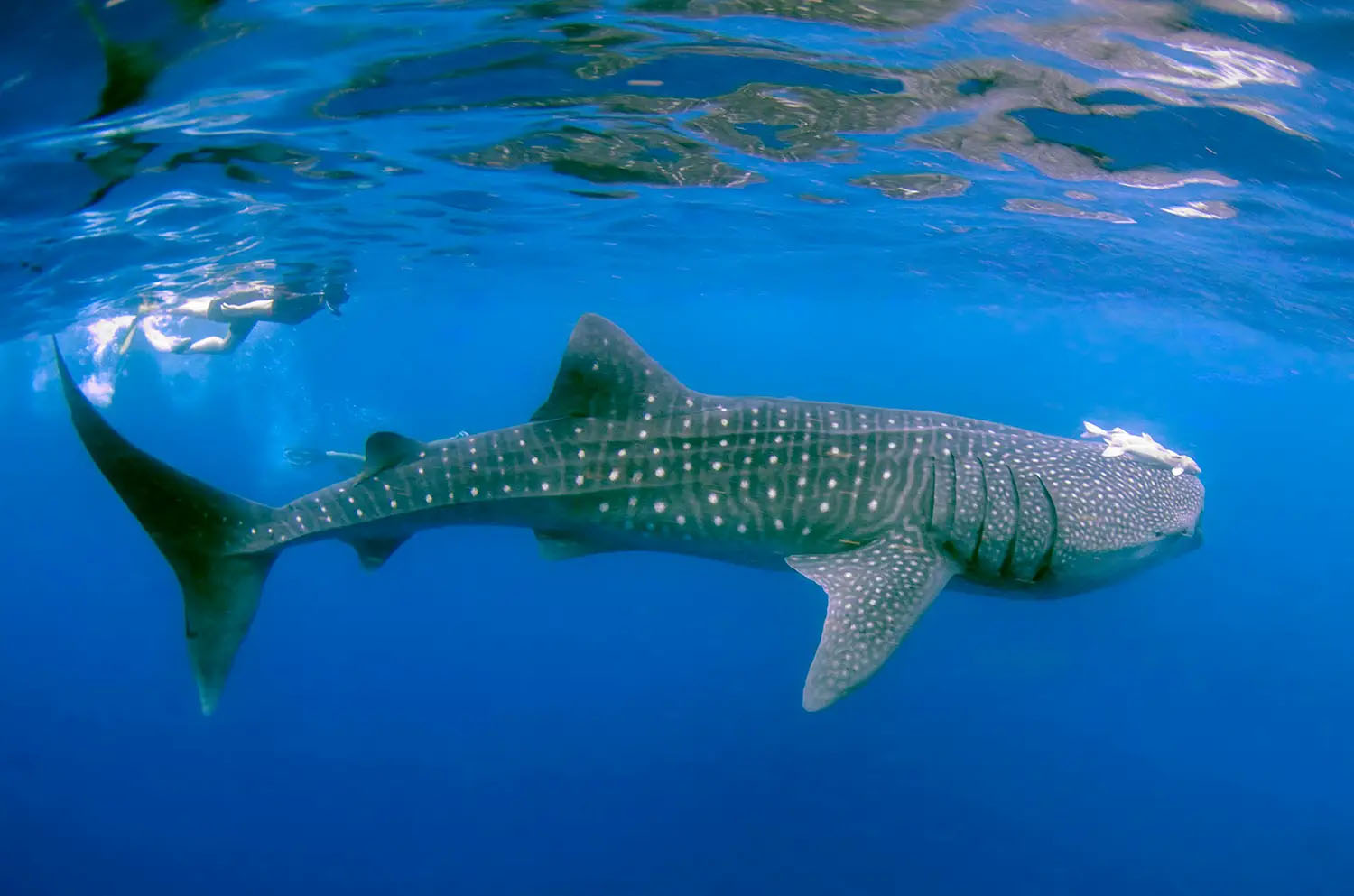
Dive alongside whale sharks. Photo by Leonardo Lamas on Pexels.
26. Relax on Gardner Bay Beach
Gardner Bay Beach, renowned for its powdery white sand and crystal-clear turquoise waters, is an ideal spot for relaxation and taking in the natural beauty of the Galapagos Islands.
Unwind on the pristine sands of Gardner Bay Beach, located on Española Island in the Galapagos. As you bask in the sun, enjoy the serene atmosphere and the sight of playful sea lions lounging nearby. The calm, shallow waters are perfect for a refreshing swim or a leisurely snorkeling session, where you can spot colorful fish and marine life.
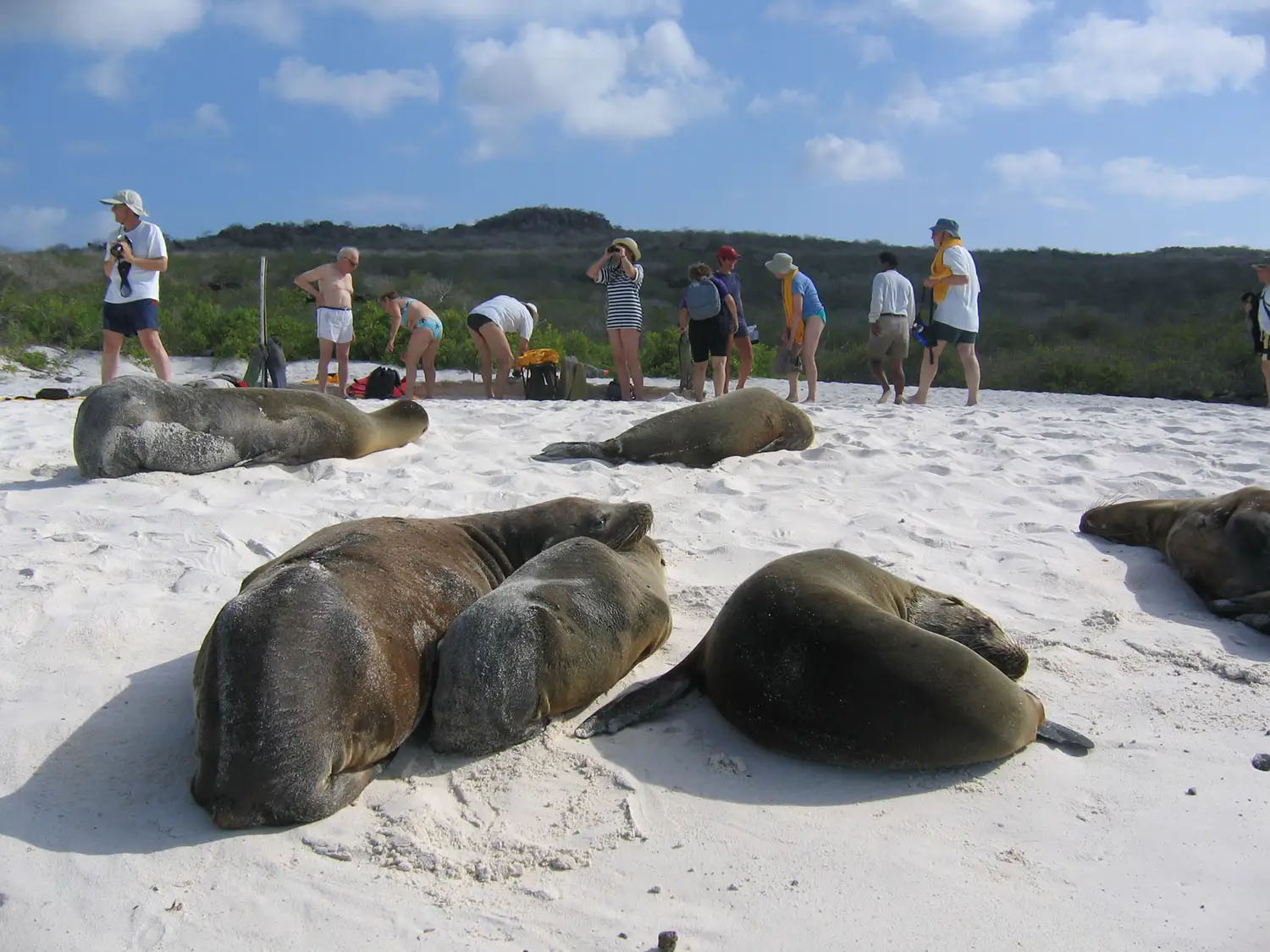
A small colony of sea lions on Gardner Bay Beach. Source: Galapagosonline aka Movera, Copyrighted free use-link, via Wikimedia Commons
27. Explore the mangroves of Elizabeth Bay
Venture into the serene mangroves of Elizabeth Bay on Isabela Island in the Galapagos. Exploring Elizabeth Bay provides an intimate and immersive experience in one of the Galapagos’ most tranquil and biodiverse habitats.
This enchanting area offers a unique glimpse into a rich and diverse ecosystem, where you can quietly paddle through calm waters, surrounded by dense mangrove forests. As you navigate the waterways, watch for a variety of wildlife, including sea turtles, rays, and playful sea lions. Birdwatchers will be delighted by sightings of pelicans, herons, and the iconic blue-footed boobies.
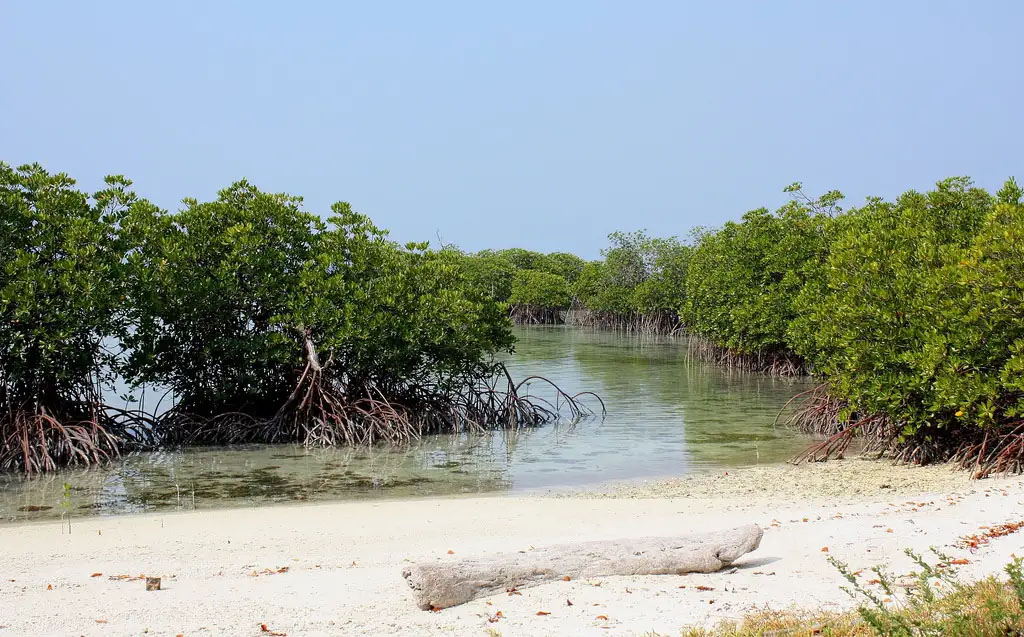
Venture into the serene mangroves of Elizabeth Bay. Photo by Dany13 on Flickr under the following license: Attribution 2.0 Generic. The full text of this license may be found here: CC by 2.0 Generic
Are you ready to discover the diverse Galapagos Islands? Simply get in touch with one of our travel advisors, who will craft the perfect itinerary for you!
28. See Los Gemelos and Scalesia Forest
Discover the natural wonders of Los Gemelos and the Scalesia Forest on Santa Cruz Island in the Galapagos. These geological formations offer stunning views and a glimpse into the island’s volcanic past.
Los Gemelos, or “The Twins,” are two massive volcanic sinkholes that are surrounded by the lush greenery of the Scalesia Forest. The enchanting Scalesia Forest is a unique highland ecosystem filled with endemic Scalesia trees, which are often referred to as “Galapagos daisies.” As you wander through the misty forest trails, keep an eye out for diverse bird species, including the elusive vermilion flycatcher and various Darwin’s finches.
Los Gemelos and the Scalesia Forest are yet another attraction that provides a serene and captivating experience of the Galapagos’ rich biodiversity and geological history.
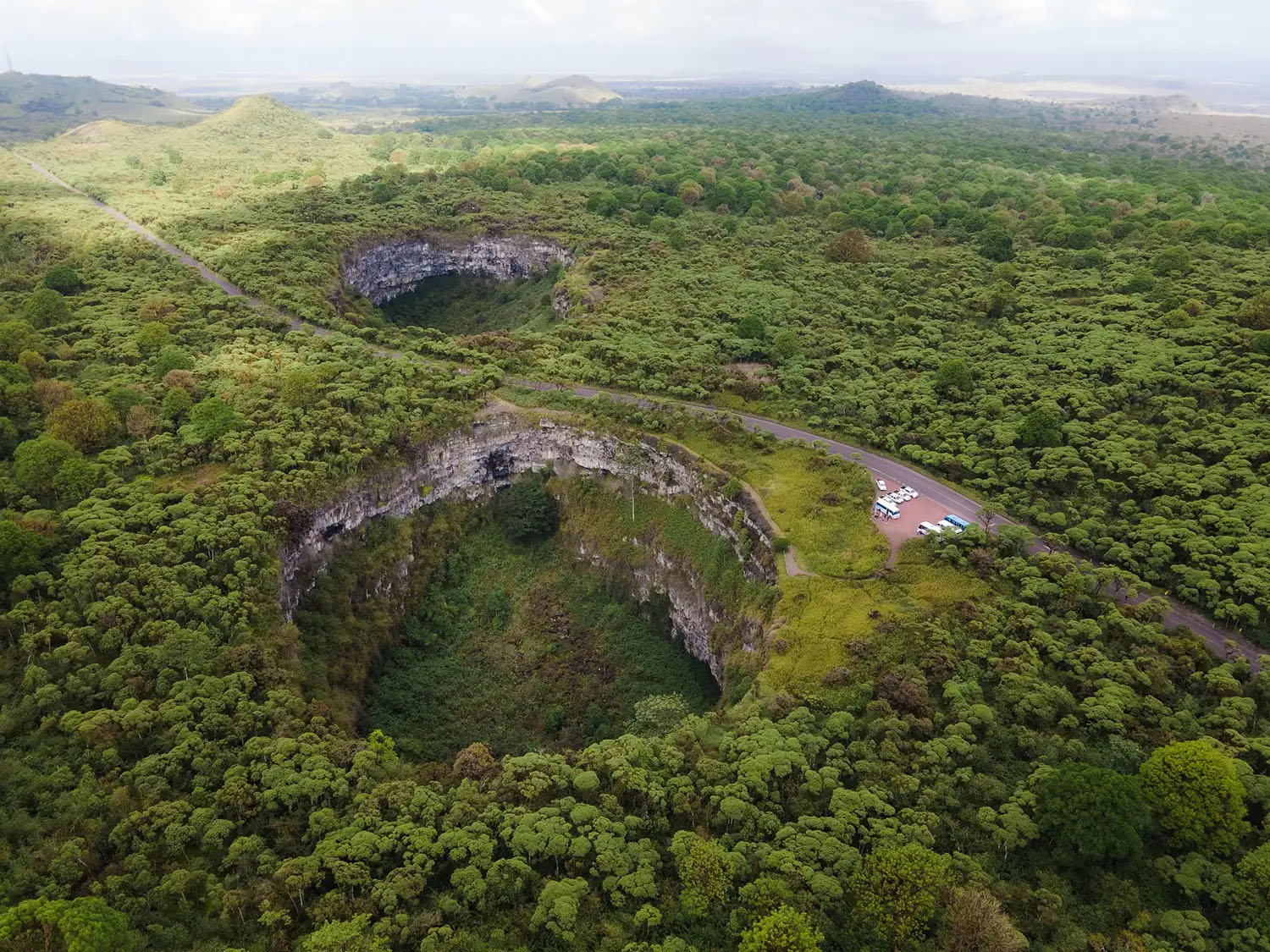
The magnificent Los Gemelos and Scalesia Forest. Photo by the Galapagos Conservancy on Instagram.
29. Explore a Pirate Cove on Fernandina Island
For pirates of old, the Galapagos Islands were a perfect hideaway. Step back in time and explore the mysterious Pirate Cove on Fernandina Island in the Galapagos.
This secluded hideaway, once rumored to be a refuge for pirates, boasts numerous coves, lava caves, and secret spots perfect for hiding treasures and ships. Its strategic location, far enough from South America and situated between trading routes to Asia and Europe, made it an ideal pirate haven. Visitors can also see historical graffiti on the cliff walls in the cove, left behind by pirates, naval soldiers, and whalers, adding to its rich and intriguing history.
In addition to being a great location for snorkeling, you’ll also encounter an abundance of wildlife, including marine iguanas basking on the rocks, playful sea lions, and a variety of seabirds.
The cove’s rugged coastline, pristine waters, and volcanic landscapes create a captivating atmosphere that sparks the imagination, and it offers a unique blend of history, natural beauty, and wildlife encounters, making it a must-see spot in the Galapagos!
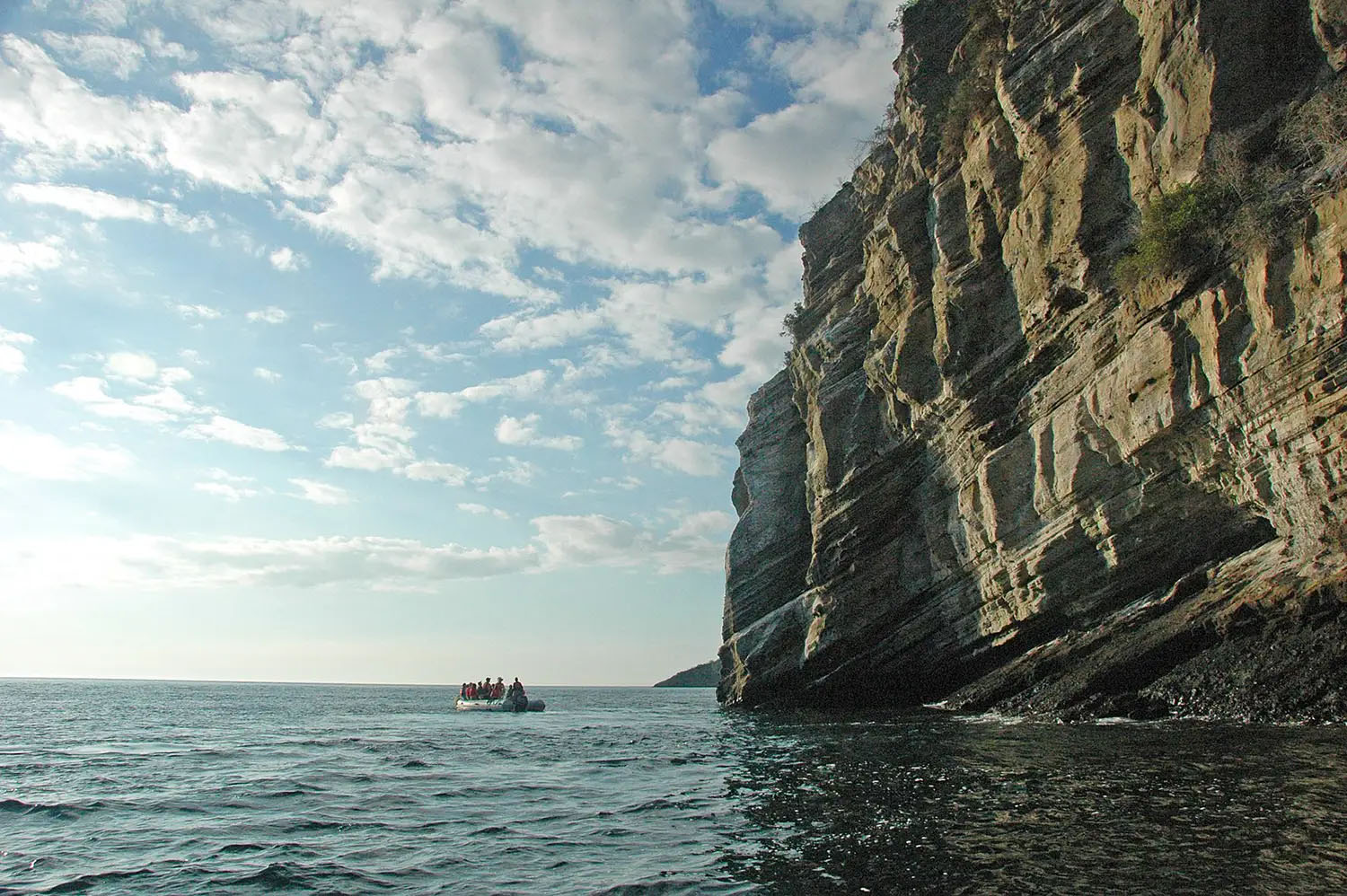
Would you, too, like to visit a pirate hideaway? Photo by David Broad, shared under the Creative Commons Attribution 3.0 Unported License.
30. See the Freshwater El Junco Lagoon on San Cristobal Island
El Junco Lagoon, located in the highlands of San Cristobal Island, is nestled in the crater of an extinct volcano. Surrounded by lush vegetation and offering breathtaking panoramic views, it is a serene and captivating natural wonder.
Although the Galapagos Islands primarily depend on desalination plants for their water, El Junco Lagoon stands out as the largest and only significant freshwater lake in the archipelago, serving as the sole freshwater source on San Cristobal Island. The lagoon attracts masses of frigatebirds, who come to rinse the salt from their wings in its freshwater. As you hike the easy trail, you can watch these birds preen their feathers while enjoying the diverse flora and fauna along the way.
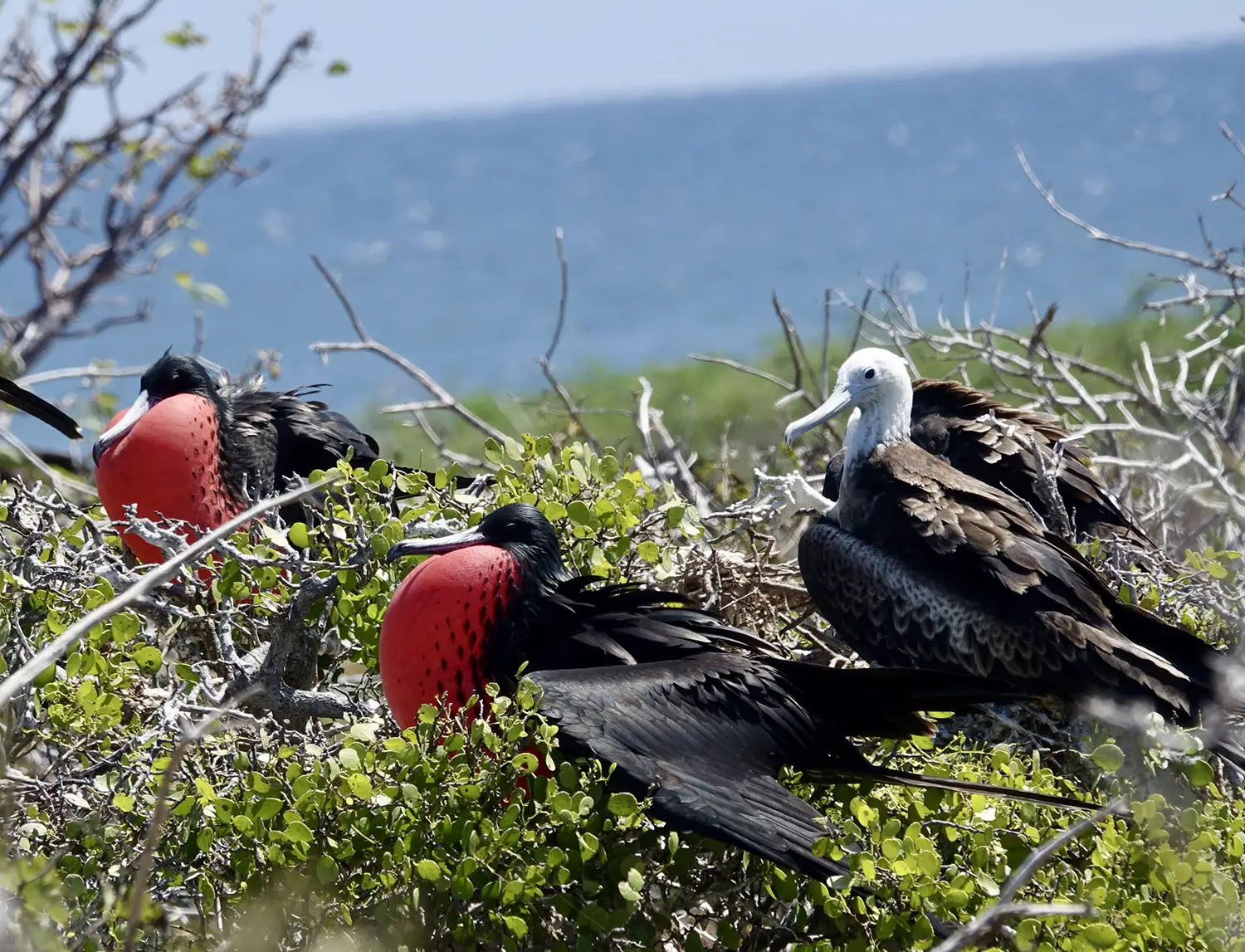
A few spectacular frigatebirds. Photo by Mike’s Birds from Riverside, CA, US, licensed under CC BY-SA 2.0 <https://creativecommons.org/licenses/by-sa/2.0>, via Wikimedia Commons
The Majestic Galapagos Islands Await
Are you ready to check the Galapagos Islands off your bucket list? We’d love to help you plan the perfect Galapagos vacation.
Speak with one of our travel advisors today to discover the best activities in the Galapagos Islands, decide which islands to visit, explore tour options, and let them create the perfect Galapagos itinerary tailored just for you!

Originally from Canada, Michelle is a wanderer who has made Peru her home since 2018. In search of the best Red Velvet cupcake, she has been eating and travelling her way through Peru and South America ever since. Obsessed with glaciers, mountains, and french fries Peru has become her home away from home.

